|
Duomo
and San Romano
San Giorgio Nuovo |
History
Built at the behest of
Guglielmo II Adelardi, on land belonging to the monastery of San
Romano, and consecrated on May 8th 1135, according to the
inscription on the fašade. But this inscription has been recently
found to date to the 15th century. Arguments rage but it seems safe
to say 'the 1130s'. The work involved Wiligelmo, famous for Modena's Duomo, and Master Nicol˛ the
architect and sculptor also responsible for impressive carving in
Verona on the fašades of the Duomo and San Zeno. The fašade here is
most impressive, especially the doorway with its tabernacle. Also
the Romanesque upper loggias, with the twisty columns. The latter
are locally said to have been created by the devil, who did it to
spoil things but was disappointed when the locals loved his work.
The exterior and narthex are the building's highlights - the south
side too is a bit spectacular with its portico of shops, the
Loggia dei Merciai built in 1473 in order to provide a viewing
platform to view the festivities associated with the duke's marriage,
but paid for by the cloth worker's guild who got a Renaissance
arcade below to replace their wooden booths.
But Duke Ercole I's major work was on the choir in 1498 by Biagio Rossetti.
This work included an enormous choir of of 150 stalls and was
completed in 1534 The wider work was still underway in 1502 preparing for the
arrival of Lucrezia Borgia, the bride of duke Alfonso. Rossetti's plans for the crossing were completed
in 1636 by Luca Danesi. The interior was ruined by work carried out
between 1712 and 1728 by Francesco Mazzarelli. Two aisles were
lost and most
of the original art destroyed. The bronze statues and Tura's organ
shutters (in the Duomo museum) are all that remains of the 15th
century work. An allied air raid on 28 November 1944
resulted in the destruction of the sacristy and considerable damage
to the apse.Fašade
The church was dedicated to the Virgin and St George, both of whom
feature on the fašade. Divided into three parts
horizontally of equal height. The lowest, Romanesque, level was
topped from the mid-12th century by the more gothic levels.
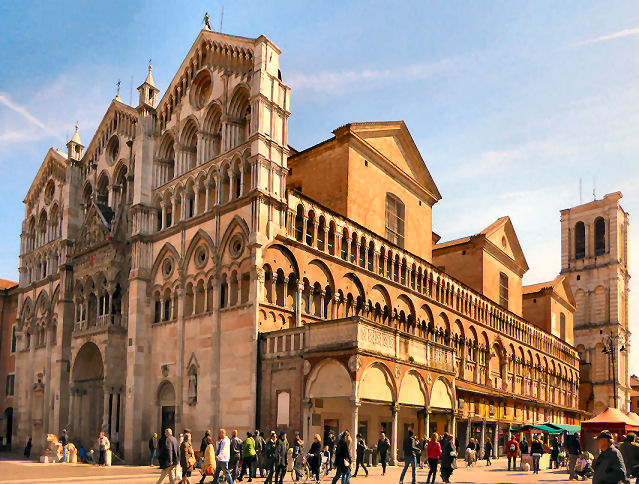 Over the central doorway is a
tabernacle with sculptures of The Last Judgement by unknown 13th
century hands. In the tympanum
above is the Redeemer, flanked by angels holding the symbols of the
Passion, and the two kneeling figures of the Virgin and St John the
Evangelist. The standing figures below in the architrave include
angels blowing trumpets and weighing souls, with the blessed off to
the left, to Heaven, and the damned off towards Hell on the
right. The four spandrels below contain figures of four of the dead
emerging from their tombs. The portal itself has Master Niccol˛'s Saint
George and the Dragon in the lunette and a frieze of scenes from the
life of Christ in the architrave. Under the central arch of
the upper loggia, there is the statue of the Madonna and Child of
1427, by the sculptor Michele da Firenze. Over the central doorway is a
tabernacle with sculptures of The Last Judgement by unknown 13th
century hands. In the tympanum
above is the Redeemer, flanked by angels holding the symbols of the
Passion, and the two kneeling figures of the Virgin and St John the
Evangelist. The standing figures below in the architrave include
angels blowing trumpets and weighing souls, with the blessed off to
the left, to Heaven, and the damned off towards Hell on the
right. The four spandrels below contain figures of four of the dead
emerging from their tombs. The portal itself has Master Niccol˛'s Saint
George and the Dragon in the lunette and a frieze of scenes from the
life of Christ in the architrave. Under the central arch of
the upper loggia, there is the statue of the Madonna and Child of
1427, by the sculptor Michele da Firenze.
To the right on the fašade is a niche with a statue the Marquis of
Ferrara, Alberto dĺEste, which was erected by the communal
government in 1393 to commemorate a papal bull granting city control
over certain church properties, which the marquis had
won for the city in 1391. The text of this bull, the Bonifaciana, is
inscribed beside the niche.
The south side of the Duomo had the elaborate Bishop's Door or
Porta dei Mesi (Door of the
Months), attributed to Nicholaus and Benedetto Antelami and
decorated between 1225 and 1230 with panels depicting the Labours of
the Months
featuring zodiac symbols and seasonal farming activities, by the
so-called Master of the Months. This doorway faced the town hall and
law courts and so symbolised the connection of church with commune.
Ferrara's governing council, the Savi, often met in the bishop's
palace and even the cathedral, which would then seem to give their
decisions divine approval. The doorway was demolished between
1717 to 1736 with some panels kept outside and some reused, upside
down, as flooring in the atrium of the cathedral, where they were
discovered in 1931 during renovation work.
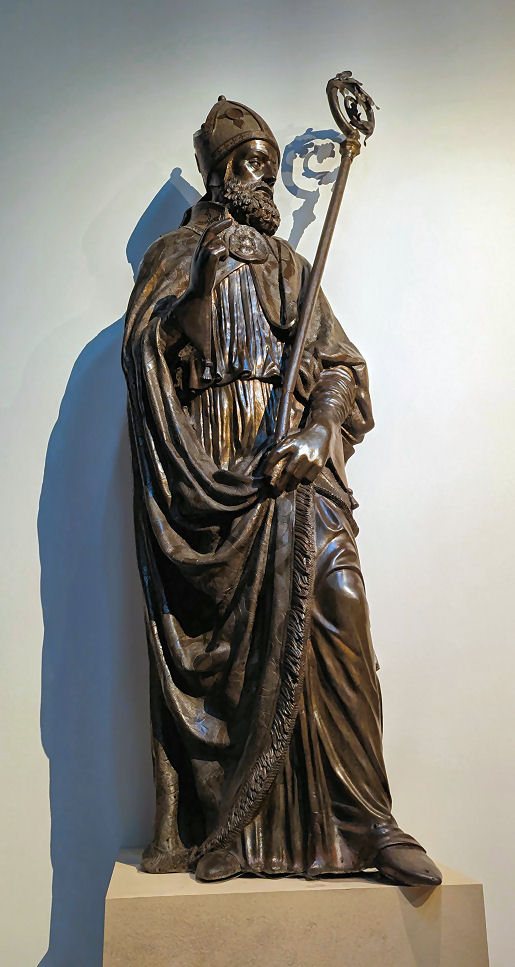 Interior
visited Interior
visited
The narthex has two ancient sarcophagi, and a pair of red
lions carrying columns which once decorated the main portal outside,
looking very like the ones by Master Niccol˛ in Verona.
On either side of the main door on the inner
fašade are two highlight detached frescoes by Garofalo, of full
length Saints, Peter and Paul (see above) , taken from San Pietro?
Seven altars each side, with the first, third and last
(transept) being bigger/full height. There was originally a
tramezzo, or choir screen, across the nave which in the mid-15th
century had life-size bronze statues of Saint George and the
Dragon, Saint Maurelius (see right), Ferrara's patron saints,
and a Crucified Christ flanked by The Virgin and
Saint John. The tramezzo is long gone, but the statues, dating
to 1450-55, by Niccol˛ Baroncelli, a pupil of Donatello, and his
brother-in-law Domenico di Paris, are now in a chapel to the right
of the high altar, where they've been since 1678.
Left aisle
Update May 2024 Yet to reopen after
restoration
Two more works by Garofalo in chapels in the left aisle - Mary as
Intercessor, painted in 1532 as a votive offering following the
plague of 1528; and a Virgin and Child Enthroned with Saints
Sylvester, Maurelius, Jerome and John, signed and dated 1524.
The last altarpiece along this north aisle is by Francesco Francia
and
depicts the Coronation of the Virgin with Saints.
Right aisle
The first chapel on the right has a very locally venerated Madonna
delle Grazie inside an 18th century polychromatic marble marble
altar by Agapito Poggi and Andrea Ferrari. Often used for services. Work by Bastianino and Scarsellino in the right-hand chapels
with, in the last chapel a Martyrdom of Saint Lawrence by Guercino
from 1629. Also a large Presepe/crib in a glass box.
The choir and apse
To the left is the tomb of Pope Urban III who died in Ferrara
in 1187.
The wooden choir stalls are early-16th-century, by the workshop of Bernardino Canozzi
and his family, from Lendinara
A fresco of the Last Judgement by Bastianino
finished in 1580
in the apse semi-dome is a copy of the one in the Sistine Chapel by Michelangelo, Bastianino's master.
It was restored in 2000 after years of restorations, ranging from
the inept to the minimal, as well as scratches caused by dusting
with a broom and smoke damage. Very blue stained glass windows.
The sacristy (not visited) has a Virgin and Child with donor by Domenico Panetti, an
Annunciation by Garofalo (originally from San Silvestro) (a Virgin
and Child with Saint
Sylvester and five more is also reported here from San Silvestro)
and a Saint Catherine of Siena by Niccol˛ Pisano, an artist employed
by Duke Ercole in the early 16th century, and he may well have
commissioned this 'for Suora Lucia'.
Lost art
Ancient stele which had been used in the walls of the Duomo are
now in the Lapidary Museum.
Tura painted a Nativity for the
Duomo in 1458 which is now lost.
Lost art
now in the Pinacoteca
A 1412 detached fresco fragment showing Saint Romanus
by an anonymous master.
Panels depicting Saint John the Baptist and Saint
Jerome Reading by another Ferrarese master from later in the 15th century.
A canvas showing Saints Lawrence and Mary Magdalene from
c.1626-32 is considered an autograph copy of a now-lost altarpiece
Carlo Bononi produced for the Bonalberghi chapel in the Duomo.
Two panels showing The
Baptism of Saint Romanus & The Conversion of Saint Romanus by Bastianino,
and a Circumcision by him, from a chapel in the left transept
here, all three
from the late 16th century.
Lost art in the San Romano
museum
Panels of Saint Maurelius and Saint George, both
looking pretty frowny, from a high
altarpiece here by Garofalo, are now in the Duomo museum.
Sculpted stone panels depicting the Labours of the Months
featuring zodiac symbols and seasonal farming activities, by the
so-called Master of the Months from beyween 1225 and 1230.
The Saint George
and the Dragon and Annunciation panels by CosmŔ Tura
which were organ doors.
The Madonna della Granna by Jacopo della Quercia, the
Madonna of the Pomegranate, commissioned in 1403 and placed on the
altar of the Silvestri family on the left of the nave in the Duomo in September 1406 (the
date on the base is 1408 but this was added later and is wrong). It
is, therefore, the earliest work that can be securely attributed to
Jacopo. It is sometimes known as the Madonna del Pane
(Madonna of the Bread) as the Scroll of the Law that the Child holds
echoes the shape of the typical bread of Ferrara.
Campanile
The foundations laid by Niccol˛ III in 1412, but little was done until Borso resumed work in 1451, the year of his succession. The first
two stories were finished under Borso, but the third was added by
Ercole. Work was suspended in 1494, resumed in 1579 with
Giambattista Aleotti overseeing the third story. Work finished in 1596
but was never completed. The lower stories are supposedly to plans
by Leon Battista Alberti,
Opening times
Weekdays: 7.30 - 12.00 & 15.30 - 19.00
Holidays: 8.00 - 13.00 & 16.00 - 20.00
May 2024 update The Duomo has been
closed since 2018, when it was announced the closure would be for,
at the most, six months. It reopened in March 2024 but the left
aisle is all boarded off and the whole church has a ceiling of
netting at column capital level. The fašade still has a column of
scaffolding up the middle with netting. No labelling of the
art as yet, or tourist-friendly lighting.
Illumination of the apse will cost you Ç2 in the coin slot.
|
|
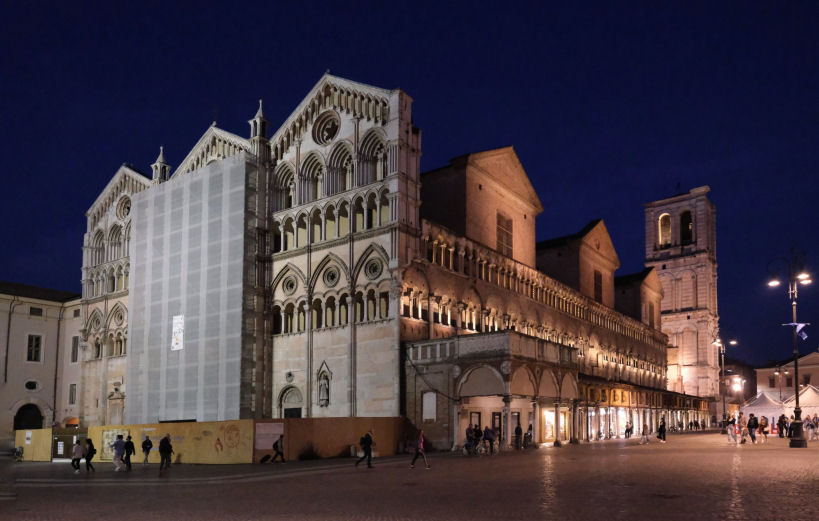

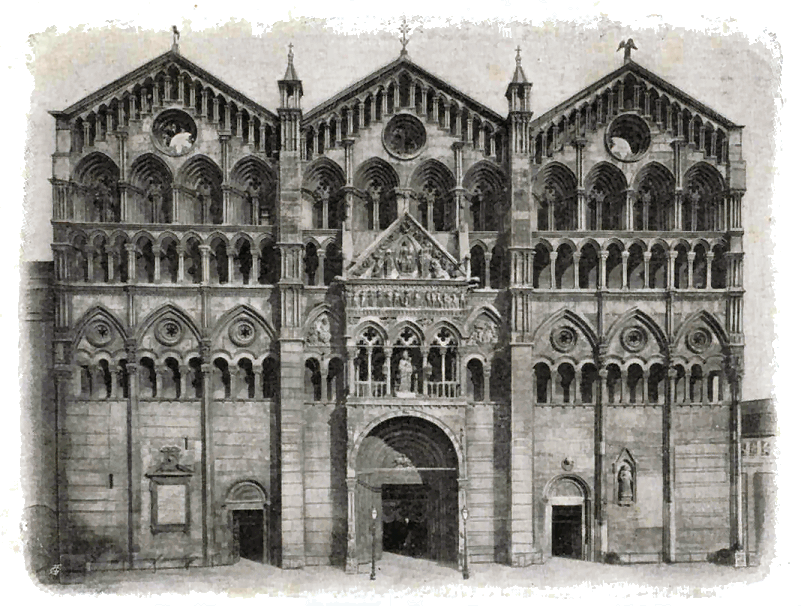
|
|
|
San Romano
The Duomo Museum
Via San Romano |
|
|
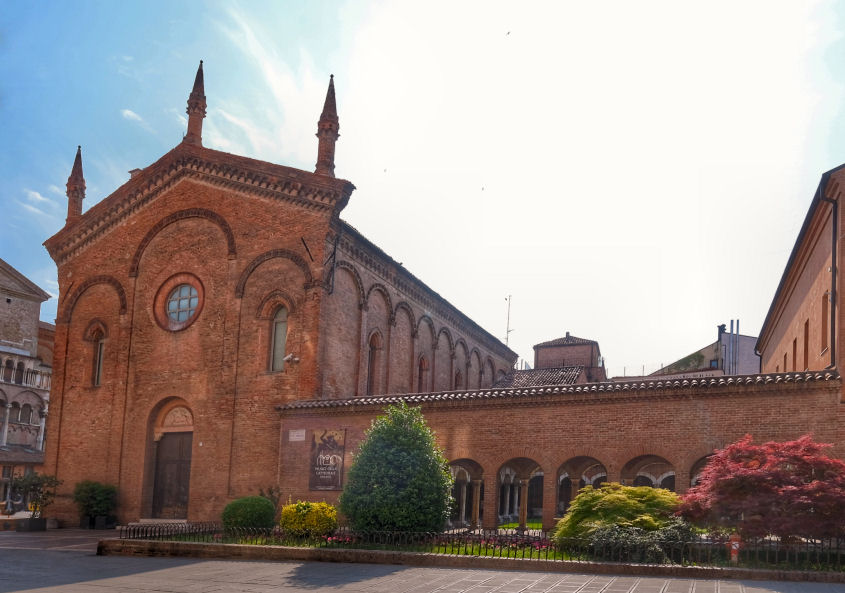
History
Initially occupied by Benedictine monks and later Augustinians, the
church was here by 990. Major work in the 12th century with its
current structure dating to the early 15th century. Amongst many
Este interventions from 1230, major work was carried out in 1287 and
1407. In 1487 Folco dĺEste instigated work making the church and
cloister taller and adding decorative terracotta elements. In the
lunette on the facade, above the entrance is the statue of a knight
from the 14th century, Saint Romanus, attributed to Master
Niccol˛, responsible for much work on the Duomo's fašade.
More rebuilding at the end of the 16th
century, in 1619, and in 1754 when Cardinal Crescenzi's will paid
for an altar to house the remains of Saint Romanus. Following
Napoleonic suppression the buildings were used as a prison. In the
second half of the 19th century two marble plaques were removed from
the wall in front of the cloister and wooden poles inserted into the
cavities so revealed, to which a noose was tied used to carry out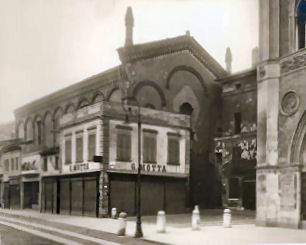 death sentences. The church was later sold to a private company and
used as a warehouse until the mid- 20th century. During the Second
World War the former church and cloister suffered bomb damage. In
the 1950s the buildings that clustered around the church were
removed and
the cloister was rebuilt. The church was restored more in the 1970s
and the cloister was used for exhibitions. The church was used for
events, including the Ferrara Buskers Festival. The church and
cloister has housed the Duomo museum since 2000
death sentences. The church was later sold to a private company and
used as a warehouse until the mid- 20th century. During the Second
World War the former church and cloister suffered bomb damage. In
the 1950s the buildings that clustered around the church were
removed and
the cloister was rebuilt. The church was restored more in the 1970s
and the cloister was used for exhibitions. The church was used for
events, including the Ferrara Buskers Festival. The church and
cloister has housed the Duomo museum since 2000
Opening times
Tuesday-Sunday 9.30 - 1.00/3.00 - 6.00
Closed Monday |
Corpus Domini
Corpus Christi
Via Pergolato |
History
Founded as a convent for Augustinian
nuns by Bernardina Sedazzari, a Ferrarese merchant's daughter, with
Nicol˛ III d'Este providing funding and helping at the laying of the foundations in 1415.
The convent was approved for Poor Clares in 1431. Most of the first nuns died of the plague but later inmates included Caterina Vigri (or Vegri) who founded the Clarissan convent of
Corpus Domini in Bologna
in 1456 and was canonised in 1712. Caterina
painted images of the Christ Child on the walls here and copied and
illustrated her own breviary, her only certain painted work. Building work here
in 1491/2 at the instigation of Duchess Eleonora, who had her own
cell here and her own oratory within the sisters' choir.
This was the convent where the foremost Ferrara families sent their daughters in the 15th and 16th
centuries and where the (mostly female) members of the Este family chose to be buried - their
pavement tombs are in the 18th-century nunsĺ choir. Amongst them
you'll find Lucrezia Borgia, the notorious daughter of Pope Alexander
VI and sister of Cesare Borgia, who came to Ferrara to marry Alfonso
I (her third husband) and who died here in childbirth at the age of
39. Two of her sons lie beside her and her first daughter Eleonora
who was abbess here. Also here are her husband Alfonso I, Ercole I
and his wife Eleonora of Aragon (who took a special interest in this
convent, frequently retreating here, where she had her own cell), and Alfonso II.
Corpus Domini echoed San Francesco, where the male Este where mostly
buried, at the other end of what is now the Via Savonarola, a street
built by Borso D'Este to encourage the wealthy and influential to
build their palazzi here. The Casa Romei was one result. In Lorenzo
Costa's famous fresco of the Virgin and Child surrounded by
the Bentivoglio family in
San Giacomo Maggiore
in Bologna Camilla, the daughter in a nun's habit, took the
veil here, her sister Isotta joining her later.
The church was badly damaged in a
fire on Christmas Day 1665 which started in a crib, with the loss
of the wall paintings of Caterina Vigri, and then largely rebuilt.
Reconsecration in 1667 with more work in 1770 by the architect
Antonio Foschini. He added the presbytery and moved the 15th-century
fašade to face into Via Campofranco.
The Clarrissans left during the
suppressions of Napoleon in 1798 but returned to parts of the complex in
1800, where they remain. By 1812 they had managed to buy back a lot
of the dispersed fittings. The complex passed to the state 1867 and
then to the Municipality of Ferrara in 1908. Most of the convent was
demolished in 1906 and a school built. In 1909 the small facade on
via Campofranco was rebuilt along its original 15th-century lines
and in 1960 Este remains which had originally been buried in the
demolished church of Santa Maria degli Angeli were moved to the choir here.
Interior
Over the high altar is a Communion of the Apostles by
Giambettino Cignaroli (1768), and there's an oval ceiling fresco of
The Glory of Saint Caterina Vegri by Giuseppe Ghedini
(1770ľ1773). Both are visible in the photo right.
A Crucifixion by Scarsellino from 1600
over the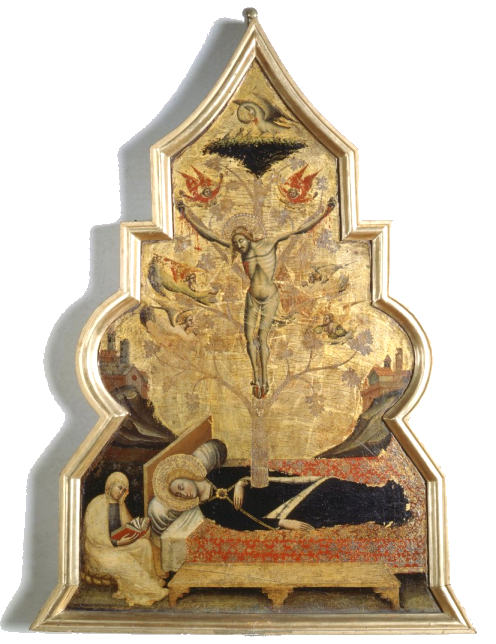 main altar. main altar.
In the separate choir there is also a portrait of Santa
Caterina Vegri by Lorenzo Garofali from 1712; The Immaculate Conception
by Maurelio Scannavini, from c.1668; and a monochrome Deposition
by
Giuseppe Antonio Ghedini. The walnut choir stalls are 18th century.
Lost art
in the Pinacoteca.
A Crucifixion panel attributed to Guariento
di Arpo from Padua from c.1360/70. It is said to have formed a small
diptych (for private use) with the Virgin and Child with Saints
Anthony of Padua, John the Baptist, Francis and Giles now in the
North Carolina Museum.
The Dream of the Virgin panel (see right)
by Simone de' Crocifissi, where the Virgin unusually appears as the
holy root of the Tree of Life.
A panel of the Entombment with Franciscan Saints by a Ferrarese master from
c.1455. It entered the Pinacoteca in 1874 attributed to Galasso di
Matteo Piva, a mystery-shrouded pupil of Piero della Francesca, said
by Vasari to have taught Tura.
A panel showing The Death of a Female Religious by an
anonymous master, maybe from Mantua, from around 1500.
Opening times
Daily 3.30-5.30 except Sat and Sun, ring at the convent
around
the corner in Via Pergolato 4 - the Franciscan nuns of the closed
order of the Poor Clares will open the door for you by remote control.
|
|
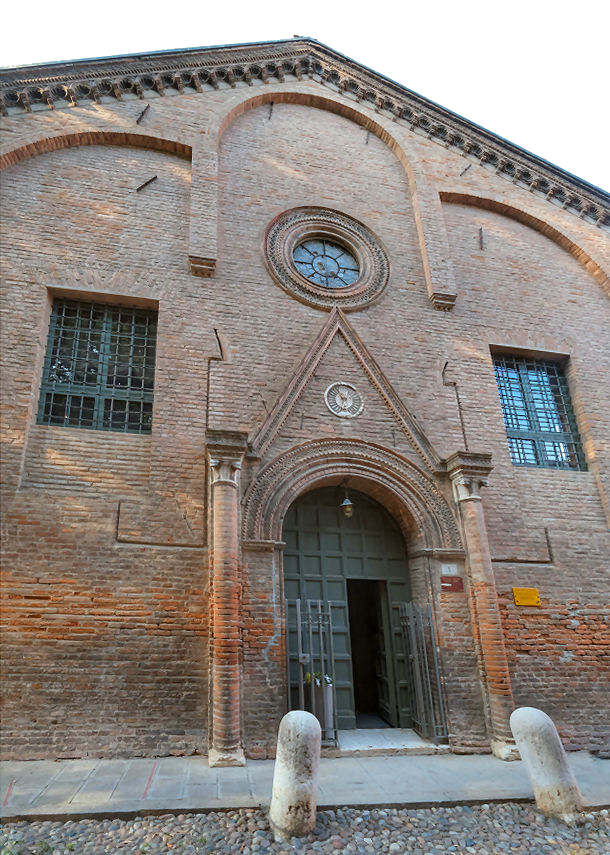
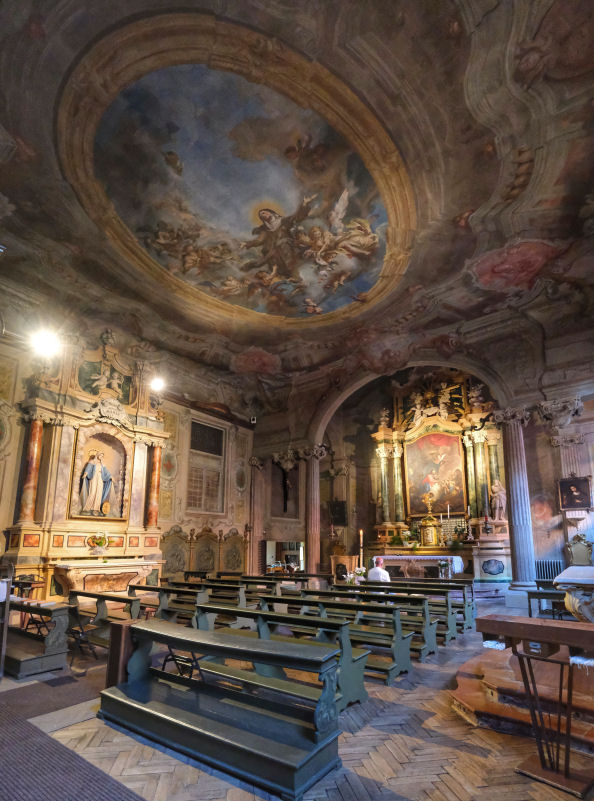
|
|
Ges¨
San Michele del Ges¨
Piazza Tasso |
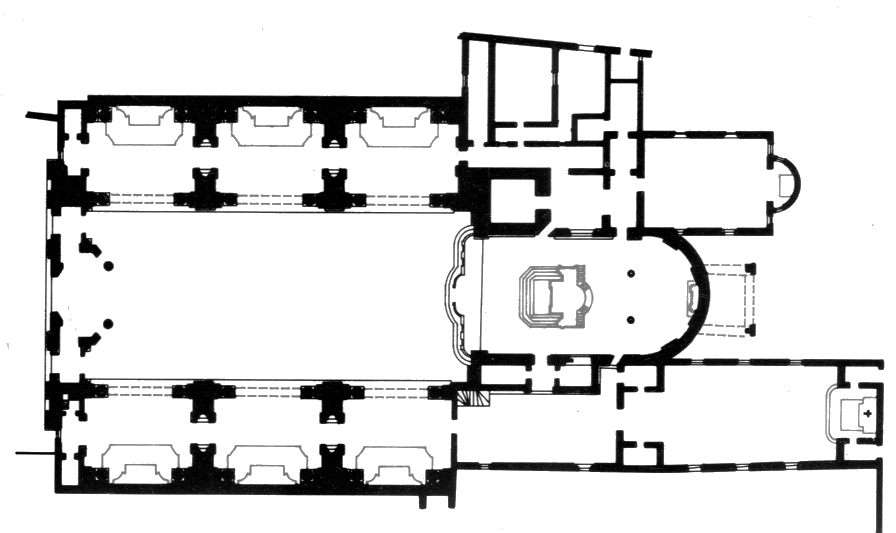
History
Built for the Jesuits in 1570 to
designs by Alberto Schiatti. Following the suppression of the
Jesuits in 1773, the church and college passed to the Somascans. In
1933 the archbishop Ruggero Bovelli transferred the Priory of San
Michele to the church of the Ges¨, which was then renamed San
Michele del Ges¨. Damaged by bombing in 1944 - the b&w photo taken
before the bombing (below right) shows the lost late-16th
century plaster ceiling
decoration. The Deposition by Mazzoni suffered scratches. In 1986 the
church's name
changed back to its current one.
Interior visited
Palely baroque, a high nave with two tall
aisles, or maybe it's aisleless with connected side chapels. Not
much light, what there is is yellow and comes from the circular
clerestory windows.
To the left against the inner fašade is one of those emotional terracotta
Lamentation tableaux by Guido Mazzoni, fully polychromed this time, with
seven life-size figures, made in 1485 (see below right). It was commissioned by Duke Ercole I d'Este and Eleonora of Aragon, who are shown as participants
in the event, along with other members of their court. The figures depicted are the Virgin Mary, Mary
Magdalene, Mary Cleofas, Mary Salome, Saint John the Evangelist,
Nicodemus, and Joseph of Arimathea. Ercole and Eleonora are cast as
Joseph of Arimathea and Mary Salome (or Cleofas). The group was originally placed
in the church of Santa Maria della Rosa
(demolished in 1950) within the Addizione Erculea (Herculean Addition), Ercole's urban expansion which
doubled the walled city's limits. The group was damaged during
the 1944 bombing but restored in 1975/6. A light switch illuminating
the tableaux is on the pillar to the left at knee level.
A deepish presbytery has a big baroque altar
from 1748, with flanking nun's
galleries and modern stained glass windows.
Altarpieces in the south aisle include an
Annunciation by Giuseppe Mazzuoli (il Bastarolo) from 1589 and
two large altarpieces on canvas dedicated to Jesuit saints by
Giuseppe Maria Crespi from Bologna (lo Spagnuolo) and his son Luigi
Crespi - the Communion of Saint Stanislaus Kostka in the
Presence of Saint Luigi Gonzaga (1727) and the Miracle of
Saint Francis Xavier (1729).
There are devotional statuettes in
the niches of the aisles. A Trinity by Camillo Filippi.
Lost art
Eight long low panels of
The Life of Christ by Bastarelo (Giuseppe Mazzuoli) from the
16th century are in the Pinacoteca.
A Landscape with a Hermit and an Angel by Giuseppe Zola from
the 18th century.
A terracotta tile depicting The Deposition attributed to
Alfonso Lombardi is in the Casa Romei.
Opening times
8.30-11.30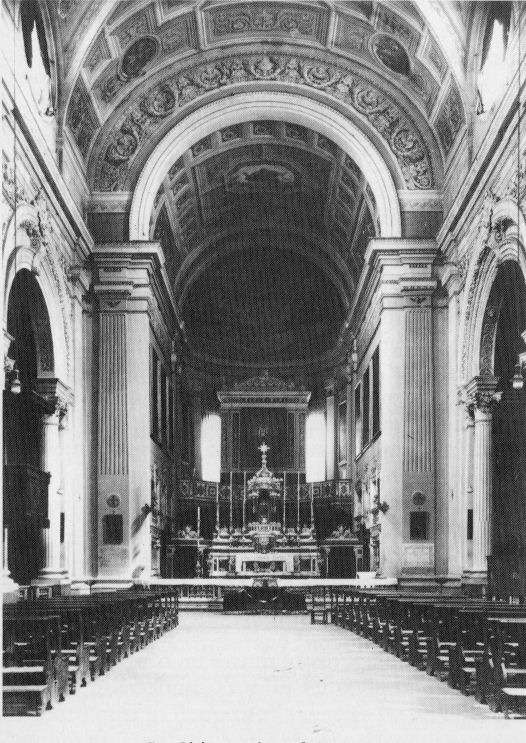
Sun & hols 8.30-1.00/4.30-6.00
Bibliography
In faciem loci - La Chiesa dei Gesuiti a Ferrara tra storia e
realtÓ costruttiva by Veronica Balboni
|
|
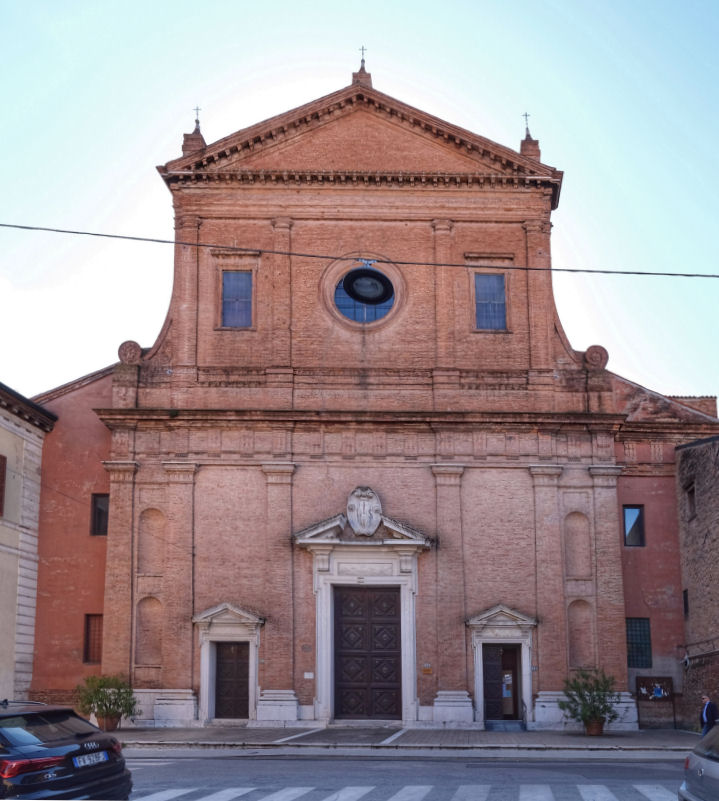

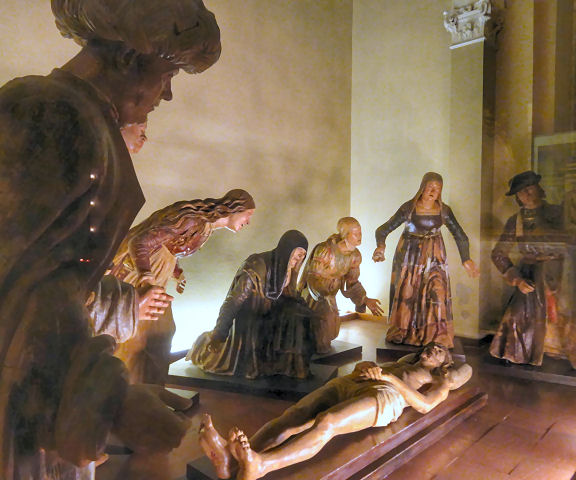
|
|
Oratorio dellĺAnnunziata
Sant'Apollinare
Via Borgo di Sotto |
History
Built in 1373 for Niccol˛ Zapponari (dall'Oro?)
who donated it to Confraternita dei Battuti Neri (or the Brotherhood
of the Black Beats as Google translates it!) The brotherhood had
been established in 1366 and was devoted to accompanying those
condemned to death and burying their corpses. The brotherhood were
also devoted to the True Cross, a relic of which the church acquired
from Isabella of Aragon in the 16th century. In 1612 they decided to
expand the oratory and the job went to Giovan Battista Aleotti, who
also designed the fašade. The two rooms of the oratory, one above
the other, was converted into one tall space. (This conversion was
reversed during the last rebuilding in 1950, after which the church
also ceased to be called Sant'Apollinare.) Further work had
resulted after the Napoleonic suppression and the First World War,
and then there was bombing in 1944 and the 2012 earthquake.
The fašade of 1612 is by Gian Battista Aleotti.
Interior
The frescoes here are attributed to Camillo
Filippi, Sebastiano Filippi (Camillo's son, also known as Il Bastianino), Pellegrino Tibaldi and Niccol˛ Rosselli
Giovanni and Francesco Surchi (il Dielai), with trompe-lĺoeil perspectives
by Francesco Scala. (The names of Garofalo and Girolamo da Carpi are also
mentioned.) The cycle of eight paintings were commissioned in 1547 by the ConfraternitÓ della Buona
Morte (another name for the confraternity mentioned above, it seems) and represent
the Legend of the True Cross, taken from the Golden Legend. The cycle begins on the right wall of the
presbytery and finishes on the left wall.
On the altar wall is a 15th-century
Resurrection fresco with members of the confraternity, attributed to
'the school of Pisanello',
maybe Antonio Alberti (or Master G.Z., as more recent attributions have
it) Above
is a 19th-century Annunciation by Gregorio Boari.
On the opposite wall is The
Madonna Giving the Belt to St. Thomas by the Flemish artist Lambert
van Noort (16th century).
Opening times
Currently closed
|
|
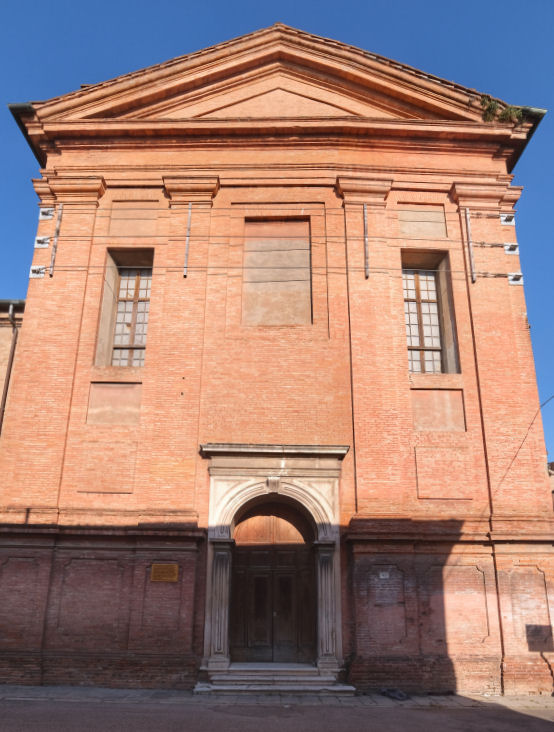
|
Chiesa delle Sacre
Stimmate
Via Palestro |
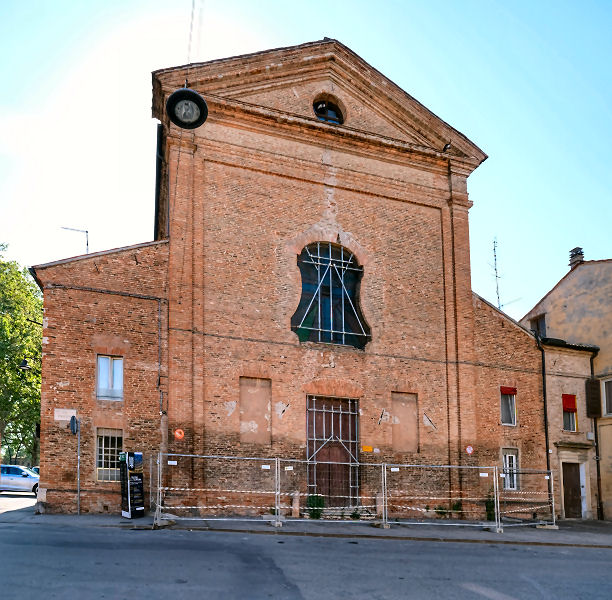 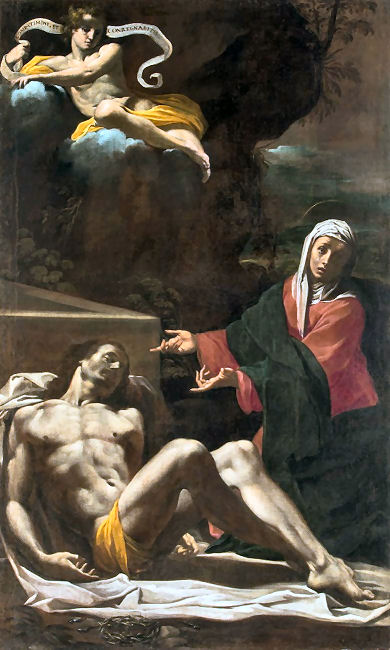
History
Dedicated to the Stigmata of Saint
Francis and built between 1619 and 1621 for the Confraternita delle
Sacre Stimmate in an area of the Addizione Erculea then yet to be
occupied. The street it faced onto was called via delle Stimmate
until 1860, when it become via Palestro, to commemorate the battle of
the same name.
Closed for worship since the 2012 earthquake
Art
Saint Francis Receives the Stigmata by Guercino 1632.
A
Crucifixion by Carlo Bononi (c.1616) and a PietÓ by Carlo Bononi
(c.1623) (see right) are both now in storage at the Archbishop's Palace.
Works by Bambini and Ferreri are mentioned too.
Opening times
Currently closed
|
San Bartolo
San Bartolomeo Fuori le Mura
Via San Bartolo |
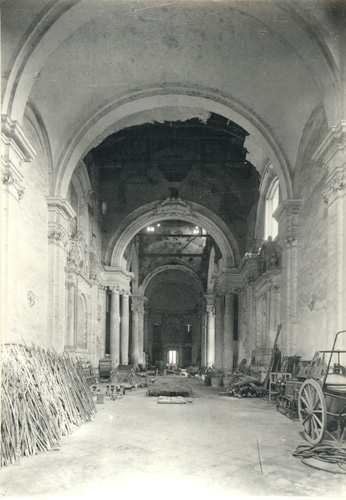 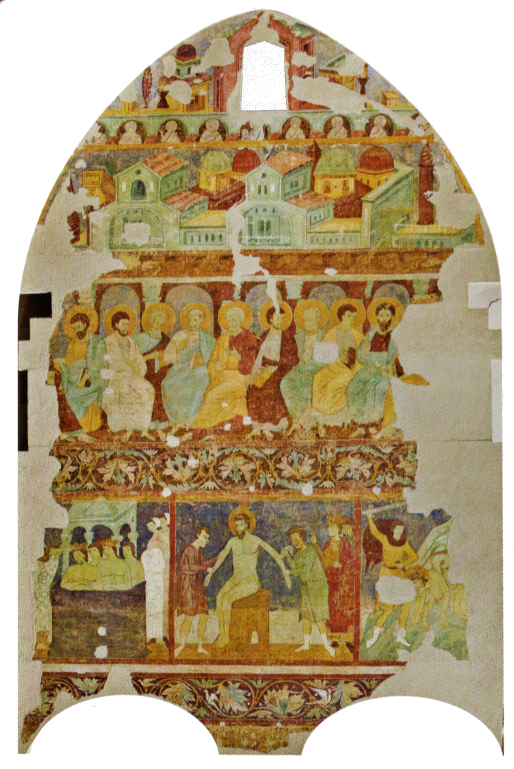
History
In the suburbs, but old and important. The Cistercian monastery was
said to have been founded by the Countess Ada, wife of Otto I d'Este, in 854 on the
feast of St. Bartholomew, the same day that her son Marino had escaped a fire
during a battle with the Venetians for Comacchio.
Severely damaged by the earthquake of 1570 and rebuilt by the architect Carlo
Pasetti. Only the church survived of the original buildings and kept its gothic
appearance, and campanile
Suppressed by Napoleon, what remains of the complex is now a psychiatric
hospital.
Lost art
Frescoes from between 1260 and 1294, including two
large ones from the presbytery and four from the apse dome,
attributed to the Maestro di San Bartolo, were detached and restored in 1955/1970
and are now in the central hall of the Pinacoteca. The two
large ones
depict The Ascension and The Apostolic College with Stories from the
Life of St. Bartholomew (see right), and then there are The Four Evangelists and an incomplete cycle of the months.
They look very Byzantine in style and colouration.
The Pinacoteca has a Nativity with Saints Alberic and Bernard of
c.1508-10 by Ludovico Mazzolino and an
Adoration of the Magi with Saint Bartholomew panel, part of an altarpiece
of 1549 by Garofalo, which has the saint looking on with his flayed
skin draped over his arm.
An unusual Visitation panel attrib to Ricamador (Girolamo Ferrari)
Tipo San Bartolo
A type of
Byzantine-inspired sgraffito (incised) Venetian slipware of the 13th century is
named after San Bartolo due to such a decorated bowl having been found inset into the
fašade here.
Opening times
Currently closed
|
|
San Benedetto
Piazza San Benedetto |
History
There may already have been a small church dedicated to Saint
Benedict here in 1492.
Building of this church began in 1496, to designs by Biagio Rossetti, for the Benedictines from Pomposa, and progressed in fits and
starts until 1553, with consecration in 1621. Following suppression by
Napoleon the complex was used as a barracks and a stable, before
passing to the Salesians in 1930.
Major damage from bombing in 1943/44 - a
British committee set up to deal with such things described San
benedetto as destroyed, but also as 'a large but not outstanding
Renaissance church' Notwithstanding this rebuilding
to its original design followed in 1952-54, but the fresco decoration by the Modenese painter Ludovico Settevecchi
was mostly lost, with just The Four Evangelists preserved in the pendentives of
the central dome. Damaged by fire in the nave in 2007, restoration is underway.
Interior
A large, long six-bay nave, with wide aisles
and six chapels each side - all with railings. Very pale and bare
and clean now, with next to no decoration, with just some remaining
painted figures in some of the spandrels and pendentives. Modern
stained glass windows, mostly full figure saints.
Campanile
By Giovanni Battista Aleotti 1621, completed in 1646
Lost art
A large very-Veronese panel of The Wedding at Cana painted for the
refectory here c.1590/1600 by Scarsellino is in the Pinacoteca.
The dark and stormy Saint Mark by the Cremonese painter Giuseppe Caletti
from 1630,
now in the Pinacoteca.
The Adoration of the Shepherds by Dielai, in the Pinacoteca since 1920.
A Circumcision of 1561 by Luca Longhi
from Ravenna, in the Pinacoteca since 1882 which, unusually, shows
the rabbi with the bloody foreskin in his hand. It was on the altar of the chapel of Santissimo Sacramento here, where it was
surrounded by panels of the Life of Christ by Nicol˛ Roselli which were destroyed by
the bombing in 1944.
Opening times
Daily 7.00 - 7.00
Update May 2024 The attractive east end
piazza (see below) is currently fenced off and full of
building work.
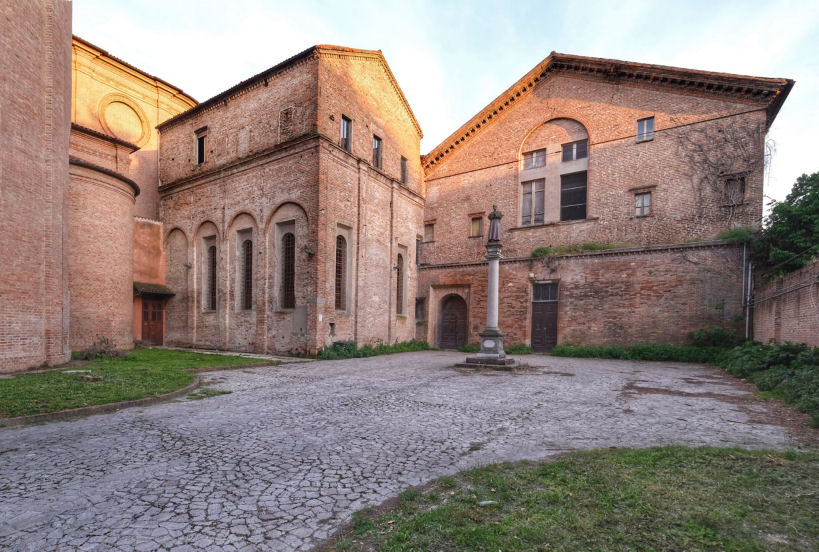
|
|
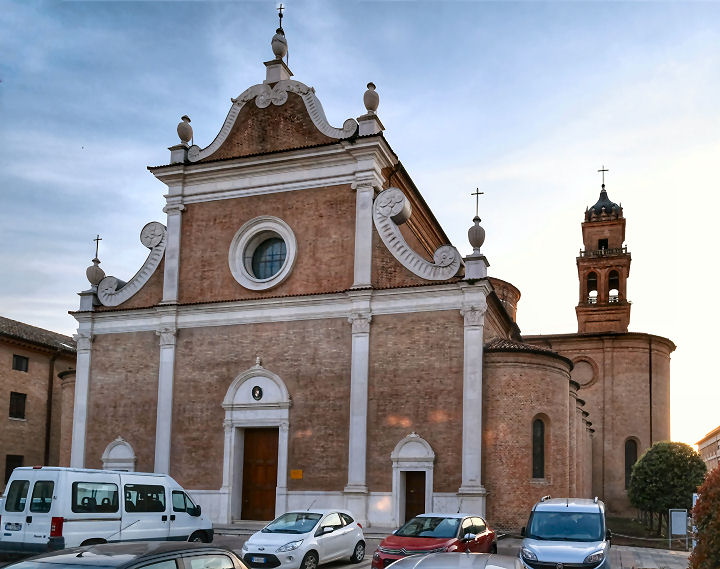

|
|
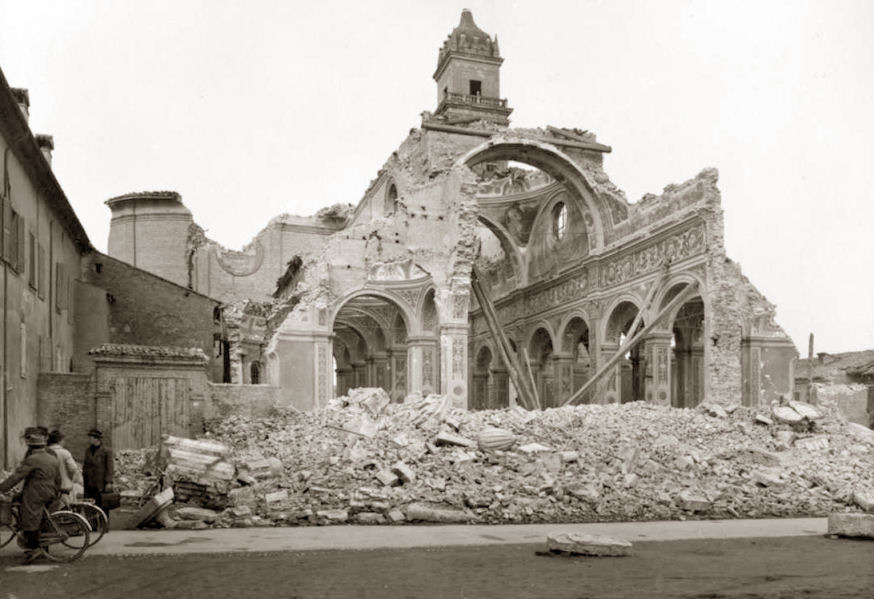
|
|
San Carlo
San Carlo Borromeo
Corso della Giovecca |
|
History
Built between 1612 and 1623 to designs
by Giovanni Battista Aleotti (L'Argenta) replacing an oratory dedicated to
Saints Philip and James designed by Alberto Schiatti, for the adjacent hospital
of Santa Anna. Closed after the 2012 earthquake, but in April 2022
the post-earthquake restoration work was completed.
The church
The baroque facade has four niches
with statues of Saints Carlo Borromeo, Anthony of
Padua, Ambrose and Augustine.. Over the door two angels
hold an heraldic shield. These angels are by an 18th century
Venetian sculptor (with a great name) called Angelo Putti,
and some have attributed the rest of the statues on the fašade to him too.
The 15th-century
cloister belonged to the convent of the Armenian friars of San Basilio and was
part of the first hospital complex of
Sant'Anna.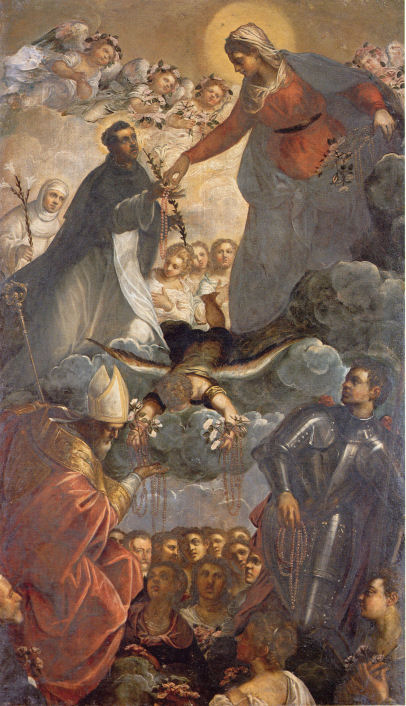
Interior
Oval-planned with two lateral chapels and a central dome.
In the nave are stucco figures of the four doctors
of the church, Saints Augustine, Gregory the Great, Jerome, and Ambrose, by 18th-century
sculptors of the Venetian school.
The
ceiling was frescoed from 1674 by Giuseppe Avanzi, collaborating with the
quadraturist Giuseppe Menegatti. In the central oval is the Virgin in Glory
with Saints Ambrose (or Maurelius) and Carlo Borromeo. The lunette
over the entrance is San Carlo by Antonio Bonfanti, who may have been a
pupil of Guercino. The four paintings of the Life of San Carlo were painted
by Carlo Borfatti.
In a niche in the left altar is a polychrome terracotta statue depicting Saint
Sebastian, looking very buff, created in the late 16th century by Orazio
Grillenzoni. The statue was originally on an altar in the demolished church of
Sant'Anna dell'Ospedale
Lost art
The Madonna of the Rosary with Saints Dominic, George and Maurelius an
early work, c.1598, by
Domenico Tintoretto (see right) now in the Pinacoteca. An inventory of
1773 said it was to the right of the high altar. It was possibly previously in
San Domenico.
Opening times
Currently closed
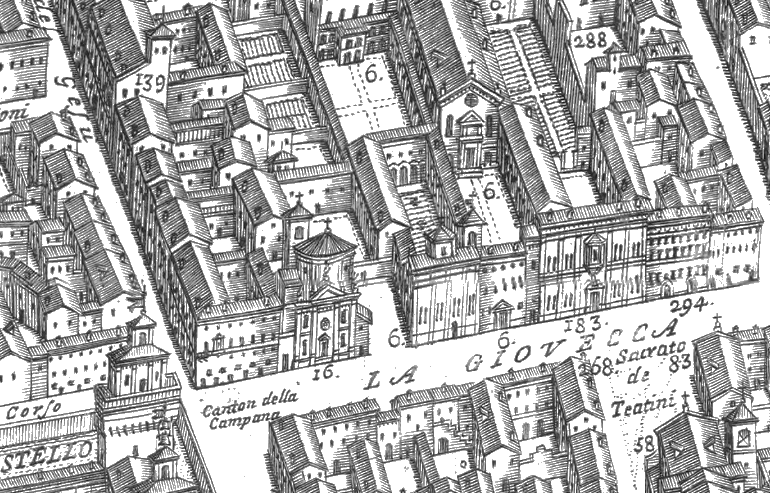
San Carlo is no.16, left of centre in this detail from
the 18th-century map of Ferrara
by Andrea Bolzoni.
|
|
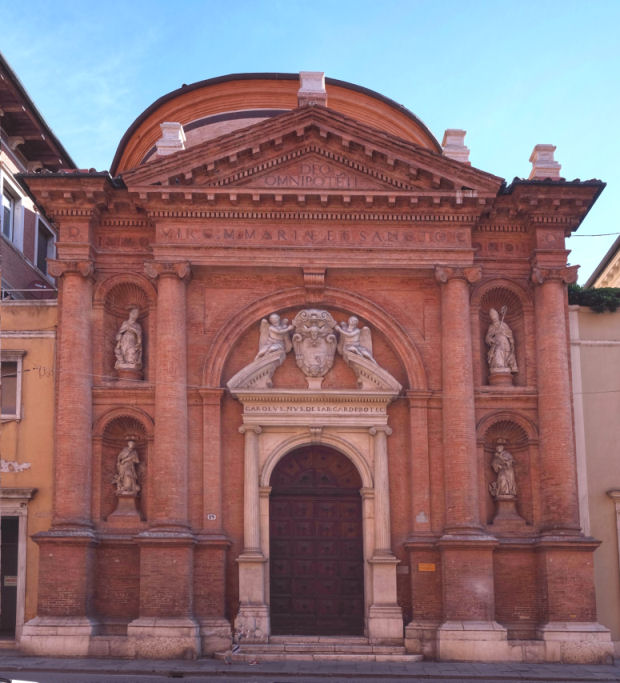
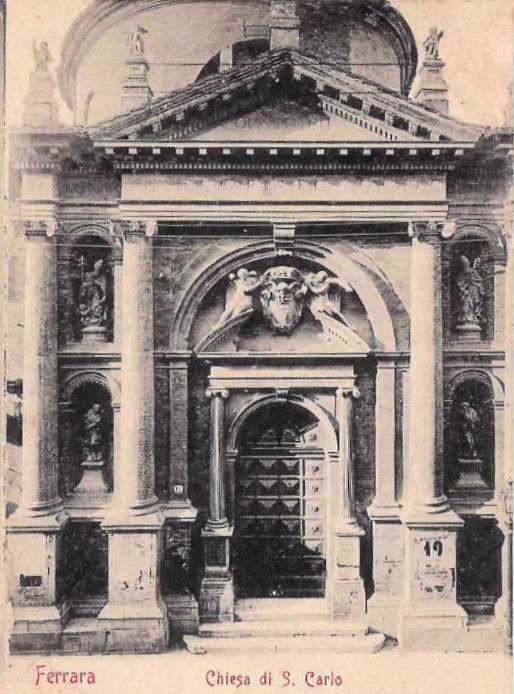
|
|
San Cristoforo alla Certosa
Piazza Borso d'Este |
|
History
A Carthusian monastery was founded
here in 1452 by Borso d'Este, the second major Este monastic
foundation, after Borso's father Niccol˛ III's Santa Maria degli
Angeli. The monks moved in in 1461. A new
church, next to the old one, was began in 1501, as part of Ercole I
d'Este's Erculean Addition, which had made the monastery less
remote from the centre of town, and completed in 1551
to designs attributed to court architect Biagio Rossetti, but not by
all scholars. The creation of the Erculean Addition had been
encouraged by how easy it had been, during a war in the early 1480s,
for Venetian forces to attack the northern edge of the city and sack
the Belfiore Palace, San Cristoforo and Santa Maria degli Angeli.
In 1799
Napoleon suppressed the monastery and it became a cavalry barracks. When the complex became the city cemetery in 1813
the church was reconsecrated. Ferdinando Canonici's enlargement
plans for the cemetery kept the cloisters but included the
demolition of the first, early 15th-century, church.
Bombing in WWII blew the top of the campanile, which crashed
into the roof
of the apse and the end of the south transept.
The fašade is unfinished, lacking its
planned marble facing, has an 18th-century portal topped by the
coat of arms of the Carthusian order, made to a design by Gaetano
Barbieri by the Veronese Pietro Puttini and Francesco Zoppo.
Interior visited
Big,
plain and pale and altogether Renaissance. the bases of the pillars
along the nave have marble bas-reliefs with the emblems of the Este - Duke Borso (paraduro/paradox, well,
unicorn), Ercole I (diamond, oak, hydra) and Alfonso I (grenade).
The six
deep chapels either side of the nave each have three rather ordinary
paintings, at least eleven of the twelve painted altarpieces being by Niccol˛ Roselli
and painted between 1565 and 1568 - the Infancy of Christ all down the left
nave to the altar and The Passion back up the
right. This is said to be the first such narrative cycle of
altarpieces.
The wooden altarpieces are by Ercole Aviati.
The intarsia-panelled choir stalls behind the altar, attributed to
Pier Antonio degli Abbati and taken from the demolished church of
Sant'Andrea, have recently been restored.
Lost art in the Pinacoteca
A Death of the Virgin by Niccol˛ Pisano. A Noah's
Ark (with a strange bulbous bottom) of the mid-16th century
which has been attributed to Dosso Dossi, amongst many others.
Two small oil paintings
on copper, The Last Supper by Agostino Carracci and The Collection of the Manna
by Ludovico Carracci,
formerly on the tabernacle on the high
altar here.
A large canvas by Carlo Bononi of the Wedding of Cana (see below) painted for the refectory
here c.1620-32. Also a Saint Bruno at Prayer with Carthusian Monks
altarpiece by him from 1624.
Saint Bruno genuflects before the Virgin and Child, a copy of
a Guercino, and Saint Bruno doing something even more
complicated at night, both by Scarsellino.
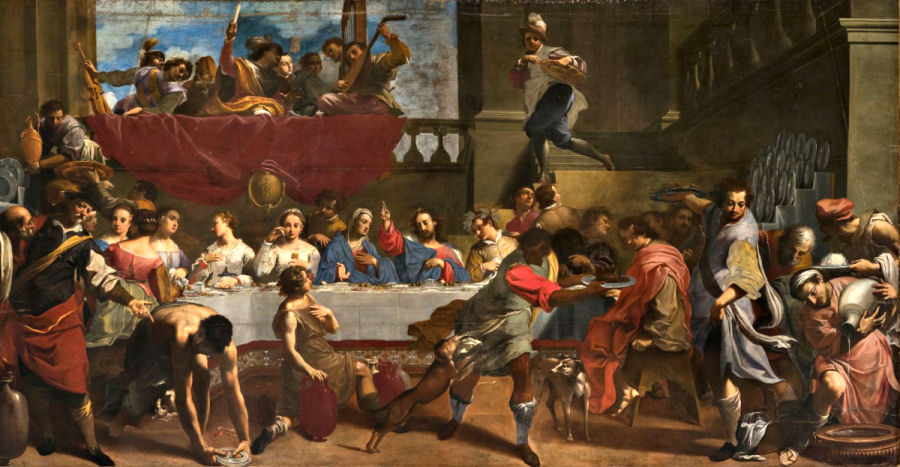
Lost art
Tura's 1458 Saint Jerome in the National Gallery,
maybe.
Quite a lot of sculpted bits and pieces from the Certosa are now in
the Casa Romei. These include a 15th century marble Virgin
and Child from a monument in the small cloister here, attributed
to the Florentine sculptor Niccol˛ de Pietro Lamberti. Also an 18th
century marble tondo of the Nursing Madonna, uncertainly attributed to
Giuseppe Maria Mazza, from the tomb of the Avogli family here, and a
16th-century Ecce Homo, from the small cloister here. An
early 15th century pulpit from the refectory too.
Opening times
Daily 8.45-5.15
The Cemetery
Following the suppression of the Monastery in 1801, and
the decision to forbid further burials in city-centre churcheyards, the
Certosa complex was
officially declared the city's main cemetery in 1813. As in Bologna
the original cloister was initially used for burials, and tombs from
suppressed churches were moved here. The first monuments were
aligned with the arches of the cloister. The cemetery soon became a tourist
attraction. Byron came in 1817 and a list of the sculpture was
produced in 1819. Archaeologist and scholar Leopoldo Cicognara was
an early burial celebrated with a bust by Canova. A second cloister
was soon needed and was designed and built by Ferdinando Canonici.
His plans kept the old cloisters but included the demolition of the
first early 15th-century church (visible to the left in the view
below) to make way for the symetrical sweep of the portico in
front. A series of expansions from the 19th century on into the
fascist era ended with the creation of the second great cloister in
1962.
|
|
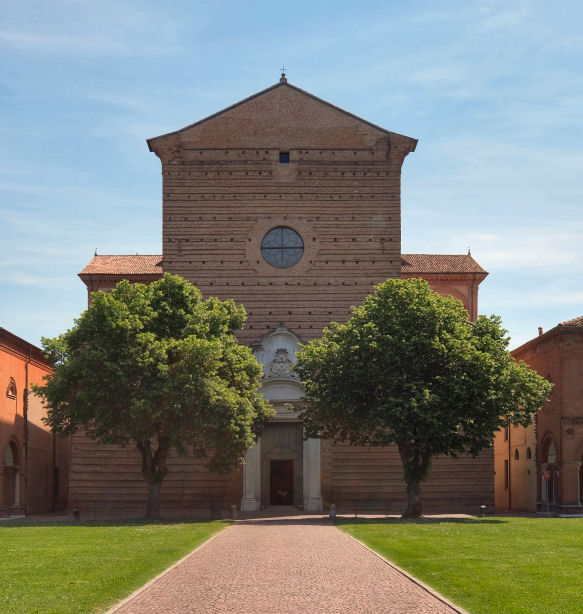
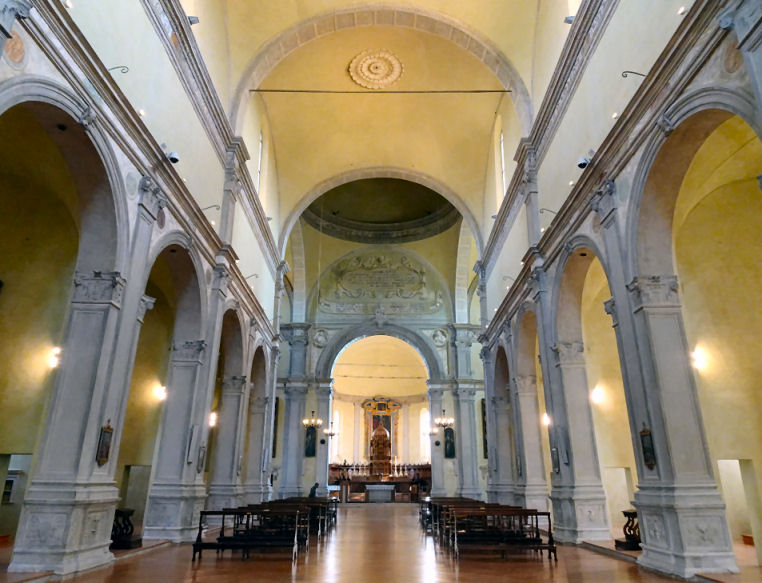
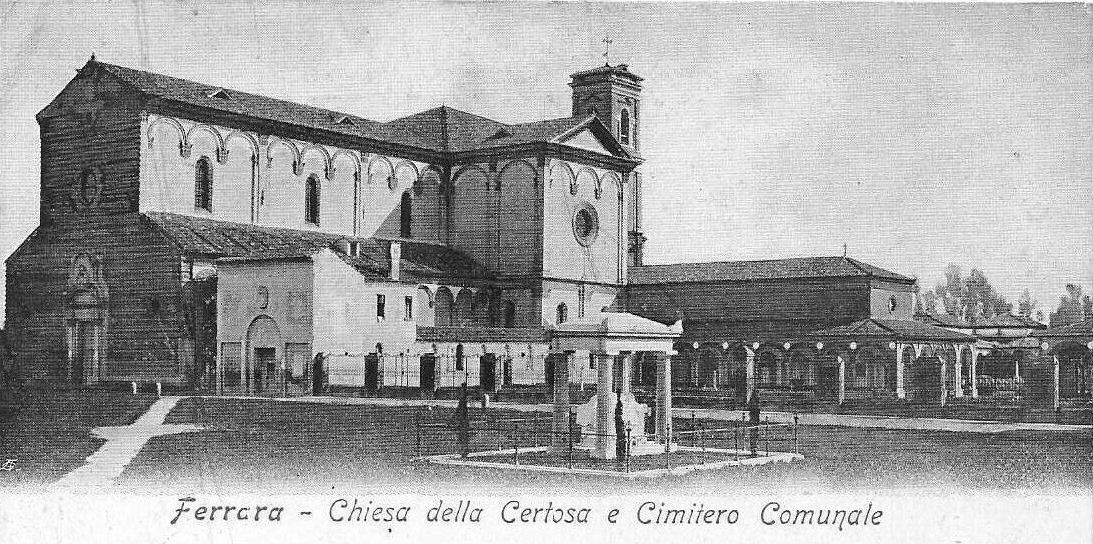 |
|
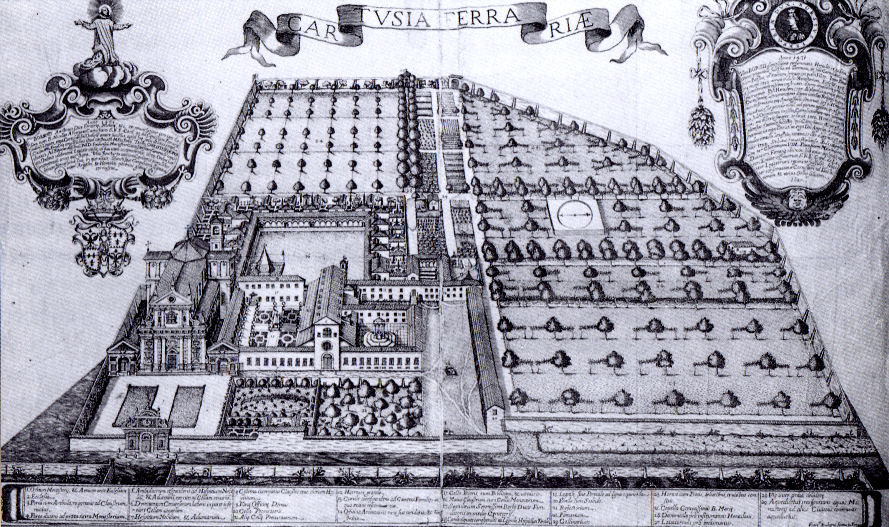
An 18th century print of the
Certosa by Bolzoni.
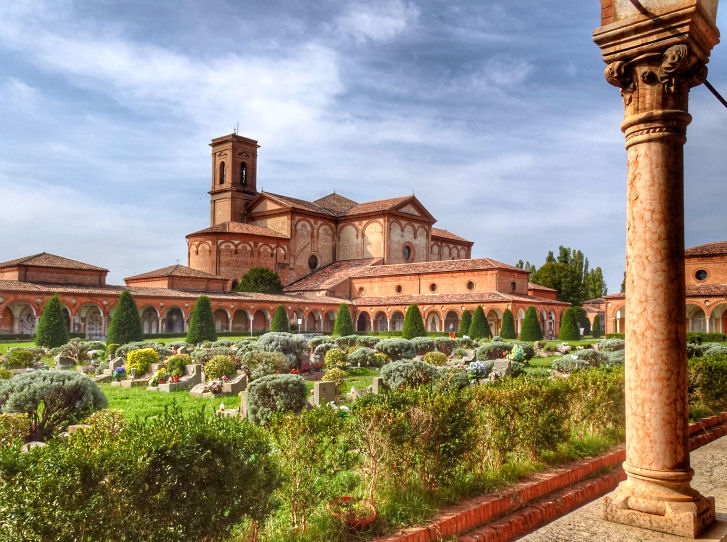
|
|
 
The
Charterhouse
Cemetery
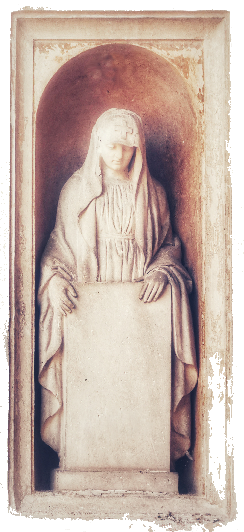
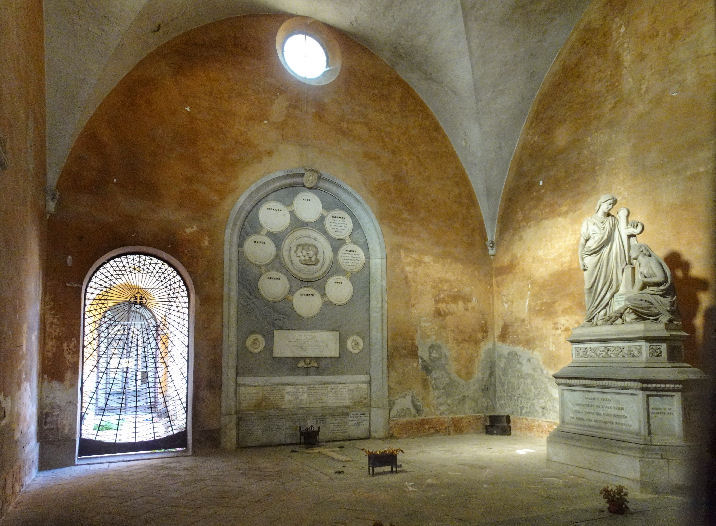 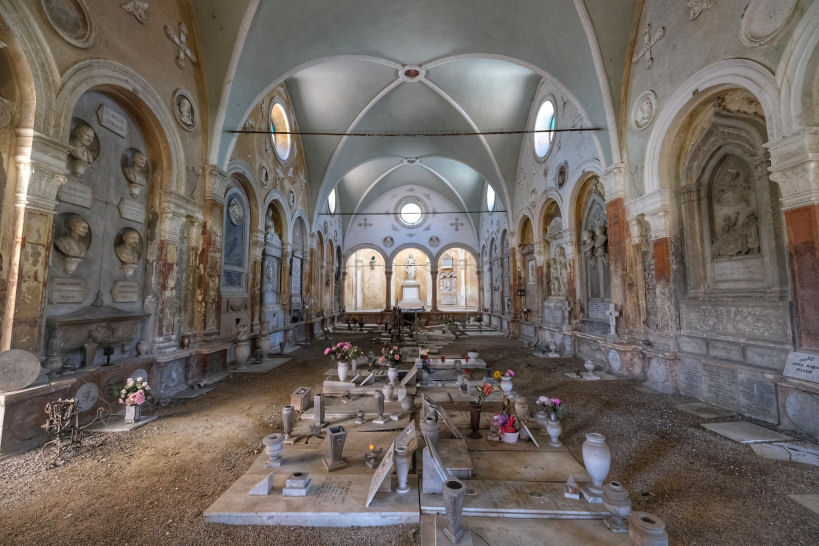
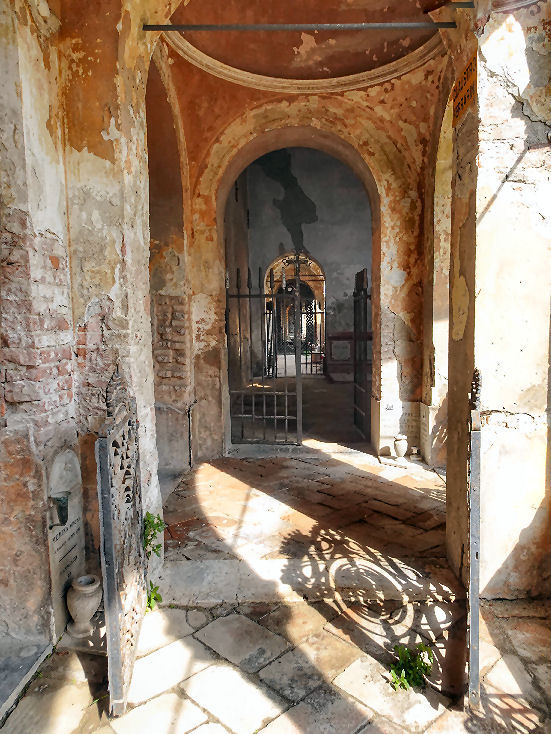




The monument to Count Massari,
completed in 1880, by Giulio Monteverde.

|
San Cristoforo dei
Bastardini
Via Bersaglieri del Po |
 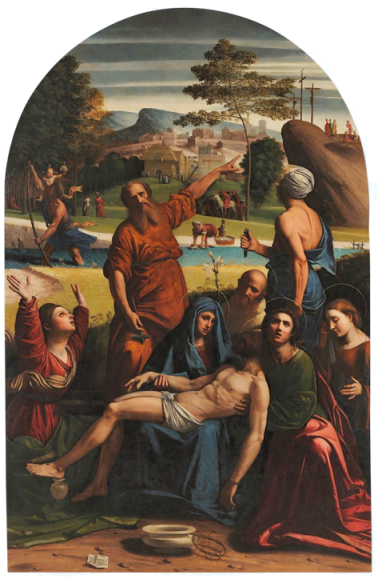
History
Until 1268 there was an orphanage (abandoned children
being termed Bastardini) with an attached hospital, called
the CÓ di Dio which had an oratory. The oratory was rebuilt as a
church in the late 14th century. In 1408 church and hospital
passed to the Confraternity of the Holy Spirit, who were here until
1515.
Restored after the earthquake of 1570 to a design by Alberto
Schiatti, with the financial help of the Duchess Barbara of Austria,
consort of Alfonso II d'Este - these last facts commemorated on an
inscribed stone plaque on the fašade.
In 1940 the complex, by now
very much the worse for wear, was acquired by the
Municipality of Ferrara and underwent restoration. Since then it has
been used at various times as offices, shops and a school. The
church today houses art events and exhibitions. I visited one of
these, but the interior seems
to have no church-like features or fixtures remaining.
Lost art
Ortolano's
Lamentation with a Carmelite Saint from 1521 (see right), originally the high altarpiece here, is now in the Capodimonte
Museum in Naples.
Opening times
Occasionally for art
exhibitions.
|
|
San Domenico
Via degli Spadari |
|
History
Founded in 1274
and completely rebuilt between 1710 and 1726 to a design by architect Vincenzo
Santini which reversed the orientation and incorporated the campanile
and the old sacristy into the fašade, the sacristy becoming the Canani chapel.
The church became the resting place of Ferrara's elite and court-connected
families. Was a centre for the teaching of medicine in the 15th
century. The friars made alterations to the monastery from 1495 and
in 1496 Duke Ercole helped pay for the rebuilding of the choir. The
original choir stalls were reused and remain.
Deconsecrated and partly occupied by local government offices. The
church is now in a sorry state, looking not to have been open in years
(since the earthquake of 2012?) it's all
fenced around with grass growing and windows broken.
Fašade
The fašade features four statues by Andrea Ferreri - the Dominican
Saints Thomas Aquinas and Vincent above, Saints Pius V and Antoninus,
bishop of Ferrara, below.
Interior
An aisleless nave with five chapels
each side. Fragments of 18th-century frescoes, by Giacomo Filippi,
Girolamo Gregori and Francesco Pellegrini.
As a Dominican church this was a centre of the Inquisition. The
'claw
marks' on a pier to the right of the entrance inside are said to have
been made by the devil himself, in frustration after having heard one of his
converts repent.
In the third chapel on the right are
two paintings with Stories of the Life of Saint Dominic by Mauro Gandolfi,
painted in 1791. In the second chapel on the left is a copy of the
Finding of the True Cross by Garofalo, the original of which
is now in
the Pinacoteca (see right). the True Cross by Garofalo, the original of which
is now in
the Pinacoteca (see right).
The third chapel on the north
side is the Chapel of the Rosary, with a polychrome marble altar,
marble bas-reliefs of the Mysteries of the Rosary and statues
of Saints Dominic and Vincent Ferrer, all by Pietro Bonatti
of Padua from 1744.
Lost art
Carlo Bononi's Miracle of Soriano ,
from c.1620, from the fifth altar on
the right, and a Madonna
and Child with Saints Paul, Lucy and Francis by Ippolito Scarsella
(known as Scarsellino) of c.1611, have both been in storage at the Archbishop's Palace since 2012. The
Dying Magdalen with the Virgin and Child by Scarsellino is also
mentioned (by Denis Mahon).
A large fresco from this church, detached in two goes in 1930 and
1932, with Stories from the Life of Saint John the Evangelist, is in
the Pinacoteca (see far below). It is a Pisanello-inspired by an unknown master, who is named from this
work, active in Ferrara in the early 15th century.
Reported fresco cycles by Serafino de 'Serafini,
CosmŔ Tura (New Testament scenes for the Sacrati family in
their Chapel of the Three Magi in 1468) and Baldassarre d'Este (scenes from
the life of Saint Ambrose) are lost. The latter was a pupil of Tura
who may have been an illegitimate Este offspring, probably of
Niccol˛ III, of whom it was popularly said that ôup and down
the Po, all were the children of Niccol˛ö.
A Lamentation painted for this church by Ercole de' Roberti
is now lost and known only through a copy in a private collection
(see photo right). It was the main panel of an altarpiece of
c.1490/95 whose predella panels included The Institution of
the Eucharist and The Israelites gathering Manna both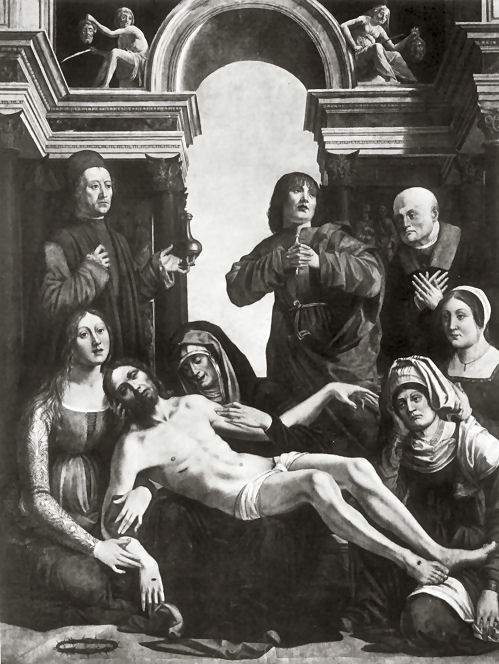 of which in the National Gallery. Another predella panel Abraham and
Melchizedek is now also only known from the copy. The Last
Supper-like central panel of The Institution of
the Eucharist has
evidence of a key-hole, so it may have been the tabernacle door. More panels,
as yet unidentified, may exist. The altarpiece may have been made to
commemorate Eleonora of Aragon, the wife of Duke Ercole I d'Este, as
the pair of them, and her brother Alfonso of Aragon, are amongst the
ring of mourners in the main panel, her husband as Nicodemus and her
brother as Joseph of Arimathea,
of which in the National Gallery. Another predella panel Abraham and
Melchizedek is now also only known from the copy. The Last
Supper-like central panel of The Institution of
the Eucharist has
evidence of a key-hole, so it may have been the tabernacle door. More panels,
as yet unidentified, may exist. The altarpiece may have been made to
commemorate Eleonora of Aragon, the wife of Duke Ercole I d'Este, as
the pair of them, and her brother Alfonso of Aragon, are amongst the
ring of mourners in the main panel, her husband as Nicodemus and her
brother as Joseph of Arimathea,
A Finding of the
True Cross of 1536 (see above right) and a Death of Saint Peter Martyr by Garofalo are in
the Pinacoteca
The Virgin Appears to Saint Liborius of 1669 by Benedetto
Gennari in the Pinacoteca since 1867.
Figures from the 15th-century sculpted tomb of Giacomo
Sacrati here by the Lombards Filippo Solari and Andrea da Carona are
in the Casa Romei (The Virgin and Child Enthroned) and the
Duomo Museum (Saints George, James, Philip and Anthony). The
Casa Romei also has a carved panel of the Virgin and Child
Enthroned with a Kneeling Bishop and two standing figures of
Saints Peter and Paul, all marble from the late 14th century.
A polychrome terracotta bust of Paolo Costabili by Alessandro
Vittoria from 1583 in the Pinacoteca, on loan since 2022. The bust
is a version of the marble sculpture made for Costabili's tomb here
which is now in the Bargello in Florence. He is wearing the
Dominican habit he took in 1534 at Santa Maria degli Angeli
Opening times
Currently closed and
crumbling

|
|
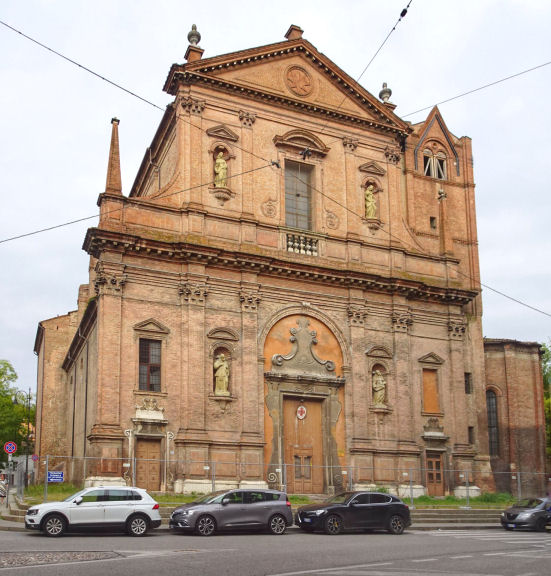
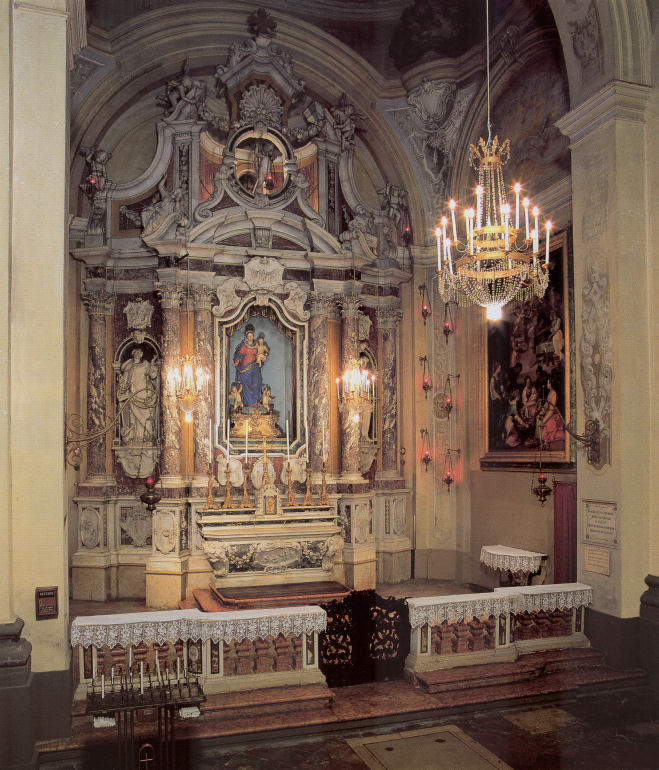
The Chapel of the Rosary, from a
book called
'Pictures from the Italian Telephone Directories 1995'
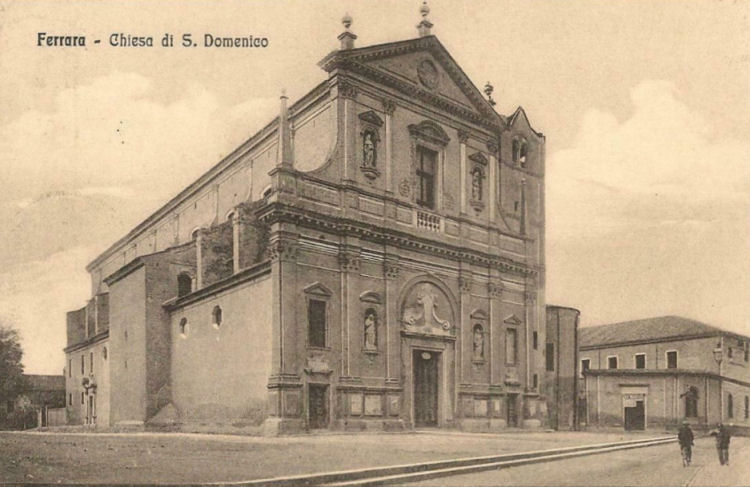
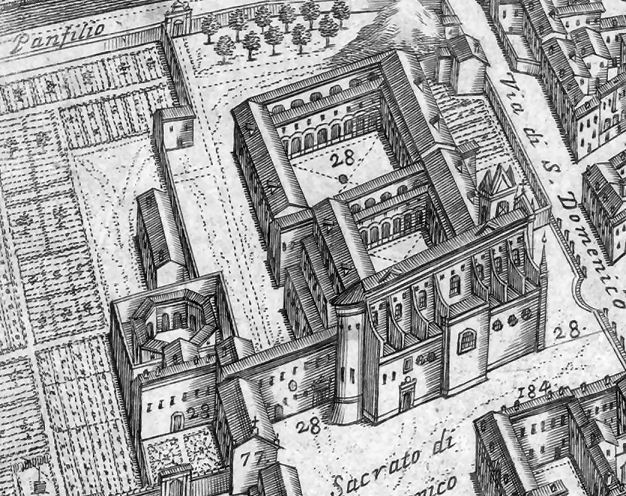
From the 1747 Bolzoni
map.
|
|
San Francesco
Via Savonarola
|
|
History
The Franciscans first came to Ferrara around
1220/22, while Francis was still alive, in the shape of Bernardo of
Quintaville. The original church, founded by Azzo VIII d'Este in 1243, was rebuilt
by Obizzo III from 1344
with a gothic church, traces of which remain, attributed to the
masters Armanno, Taddeo and Falconetto da Fontana. During the 14th
century this church was the chosen burial place of the Este family.
In 1393 Alberto d'Este commissioned Bartolino da Novara to build the
Arca Rossa here, a family burial chapel.
The Renaissance church we see
today was built following the demolition of the old one in 1495 by Biagio Rossetti,
to the plan by Brunelleschi for San Lorenzo in Florence. The actual
building, though, was contracted out to Bartolomeo di Regino and
Andrea Fiorato. Consecration
followed on 17th November 1508, but more rebuilding was needed following
the collapse of of some chapels in 1515. This took place from
1517-30 and more was needed after the big earthquake of 1570. This
work resulted in the church reopening in 1594 and also did damage
to Rossetti's original conception. Less intrusive preservative
restorations followed in 1849-60, with work on the vault and pendentive
frescoes of Domenichini later in the 19th century and work from 1954
replaced the terracotta floor with the current marble one, with work on
the fašade too. This latter work has been described as overzealous and
resulting in and leaving the church 'an antiseptic reminder of
Biagio Rossetti's style'.
Recent work has sought to return the church to its 'old
splendour' and counter the effects of the 2012 earthquake, after which the
church was closed, but has now reopened.
Fašade
Wide, brick and Renaissance in style. The
doorways date to 1885 and are the work of Ambrogio Zuffi. The scrolls
holding up the central upper level mean that the influence of Alberti is
sometimes mentioned, because he put similar scrolls on
Santa Maria Novella
in Florence, presumably.
Interior
visited
Big, very big, in that open Franciscan way - the nave is eight arches
long, with Ionic columns, but well lit with two windows in each of the
sixteen nave chapels, which are minimally decorated. Some surfaces have
fresco decoration, mostly in grisaille. The figures of Franciscan saints and worthies
in the frieze above the arches and in the aisle vaults, are by Gabriele Bonaccioli, Angelo Bonacossi and Tommaso Carpi, local artists in the 16th
century, with a later cycle added by Girolamo da Carpi. Then came Girolamo
Dominichini who painted the four large arches of the cross and the
twenty-eight pendentives of the dome in the nave.
The church is dominated by
some very ordinary art, mostly from the 16th and 17th centuries, and many
copies of panels by Garofolo, the originals of which are now in the
Pinacoteca, but a couple of his works in fresco remain.
Left aisle
Much work in the church
in recent years, after the earthquake of 2012, and it continues (May 2024)
in the first chapel on the left, still full of scaffolding. This one, commissioned by Francesco Massa
di Argenta, has a high relief of 1521 of The Agony in the Garden, by Cristoforo Borgognoni and Battista Rizzi from Milan. The altarpiece and
Annunciation above are by them too. But the two kneeling donors (Cristoforo and
his wife), the two grisaille prophets (Zaccharias and Jeremiah) and a fresco of
The Taking
of Christ (1524) are by Garofalo. During the restoration of the latter
its sinopia was discovered, confirming the dating.
The third chapel has a copy, by Girolamo Domenichini, of Garofolo's
Resurrection of Lazarus of 1534 and the fourth has a
copy of his Rest on the Flight into Egypt by Giovanni Fei,
both the originals being now in the Pinacoteca.
The sixth chapel has a 1598 copy by Scarsellino of The
Apparition of the Virgin to Giulia Muzzarelli by Girolamo da Carpi, the original is now in
the Kress Collection, on deposit at the National Gallery in Washington. It
has been through many salerooms down the centuries, on occaisions
attributed to Palma Giovane and Carracci. The seventh has an
altarpiece of the Rest on the Flight to Egypt by Scarsellino.

The crossing and presbytry
The left crossing arm
contains a 5th-century sarcophagus and the Franciscan Saints panels
on the organ balcony are by Carlo Bononi.
The grand gold-famed triptych behind the high
altar depicts The Resurrection, Ascension and Deposition by Domenico Mona
(1580-1583). Below the main panels are five small panels of Franciscan saints by Nicol˛
Roselli.
The first chapel right of the presbytery has a sweet
13th-century Madonna della Grazie panel.
The right crossing arm also has the overpowering and incongruous
baroque cenotaph (see right) of Marchese Ghiron Francesco Villa, a Ferrarese
condottieri who lead armies c.1668 for Venice in the ill-fated defence of
Candia against the Ottomans. The memorial has a statue of the Marchese by
Emanuel Tesauro and bas-reliefs depicting his feats as a general.
Right aisle
The last chapel,
dedicated to Saint Anthony of Padua, has some good and tantalising fresco
fragments of 1504, from the earlier gothic church, by Fino and Bernardino
Marsigli.
Between the 6th and 7th chapels
on the right is a Flagellation with a sculpted terracotta
Christ at the Column and two frescoed flagellant figures which are
often attributed to Garofolo.
The chapel to its left, the chapel of Our Lady of the Pilaster, has a Virgin and
Saints copy of an original by Garofalo (?Virgin and Child with Saints John
the Baptist and Jerome and the donor Trotti 1517?see Lost art), now in the Pinacoteca. There are
two more copies of Garofolo paintings in chapels nearby
- a Massacre of the Innocents dated 1519 (the copy by Giovanni Pagliarini) from
the forth (Festini) chapel; and an Adoration, both originals now in the
Pinacoteca. The fifth chapel has nice decorative fresco work, as do most
of the chapels this side.
Este burials
In the Arca
Rossa, made of red Verona marble and dedicated to the Virgin and Saint
George.
from Marchese Azzo IX to Alberto III and their wives. Internments include Obizzo II d'Este, and Nicol˛ d'Este, son of Leonello d'Este,
executed after an unsuccessful coup in 1476.
Ercole, who had once tried to poison him, had him sewn back together and
buried here. Also the ill-fated lovers Ugo d'Este and Parisina
Malatesta
Campanile
To the left of the apse. Now a 31 metre high stump, having been
built in the 17th century to be the tallest in Ferrara, but then having to
be more than half demolished as it had begun to lean dangerously in the
direction of the church
Lost art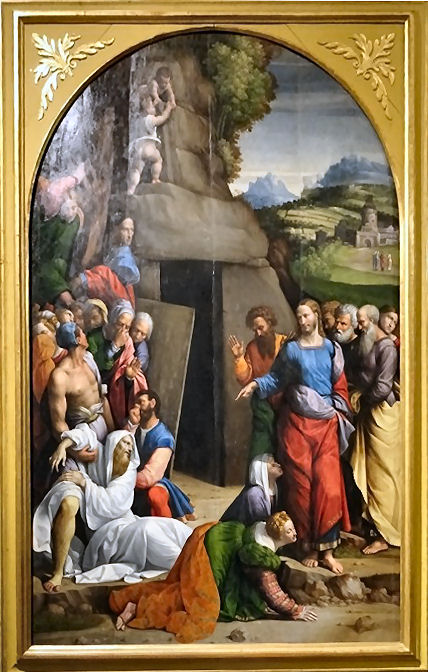
A very damaged 14th century gable-shaped
fresco attributed to Francesco da Rimini, from the old refectory here, is
in the Pinacoteca.
Cosimo Tura's Saint Jerome, now in the London National Gallery, has been reported as
being from this church.
A Saint Francis Receives the
Stigmata, with Saints Peter, James the Major and Louis, from
c.1515-20,
by Calzolaretto (the little shoemaker) (Gabriele Cappellini) a long-serving pupil of Dosso Dossi,
in the Pinacoteca since 1865.
Many by Garofolo. His Raising of Lazarus (see right),
was his last work for this church, from the Bonaccossi
chapel and a Virgin and Child
Enthroned with Saints Jerome, John the B, Anthony of Padua, another saint, and Lodovica
Trotti (the Madonna del Pilastro) of 1532/1525 have been in the Pinacoteca
since 1864. In the latter the Child grasps a carnation (Garofalo)
something of a signature for this artist. Also his Nativity
of 1512 from the sixth chapel on the left here. A Nativity with the
donor, Lionello del Pero in the Pinacoteca is from 1525/6, and so
probably not the same painting as the aforenamed.
Also by Garofalo, a relatively non-stabby
Massacre of the Innocents main altarpiece panel, dated 1519, with a Rest on the Flight
lunette, from an altarpiece once in the Festini chapel, fourth on the
right. Also a Circumcision
predella panel from the same altarpiece is now in the Louvre. It is
known to have been removed from the altarpiece and replaced with a copy as
early as 1632.
A Nativity and an Adoration of the Magi by Dosso Dossi
of 1512/13, in the Pinacoteca, have long been said to have been parts of
the predella of this altarpiece. Recent
scholarship points to their having been originally painted for private devotion, even if
they did find their way to this predella by 1739 when they appeared in a
manuscript guide to this church.
A Rest on the Flight tondo of 1525 by Ortolano (now also in the
Pinacoteca) topped the altarpiece in the
18th century, despite the lunette below being of the same subject. As
you may have noticed the altarpiece formed a quite concentrated sequence
of scenes from The Infancy of Christ.
The Apparition of the Virgin to Giulia Muzzarelli from c.1530/40 by Girolamo da Carpi
is now in the National Gallery in Washington, with a copy in a poor state by Scarsellino now replacing it here.
Another work by Girolamo da Carpi, The Miracle of Saint Anthony in the Casa Obizzi, is in
the Pinacoteca. Attribution to Garofalo has confused things lately.
An impressive Deposition panel from c.1540-60 by a Dutch
master is in the Pinacoteca.
Il Beato Andrea Conti by Giuseppe Alemanni from the early
18th century and an anonymous Saint Jerome from the same
century from the Novara family altar here.
Opening times
8.00 - 12.00 & 3.30 - 6.00
|
|

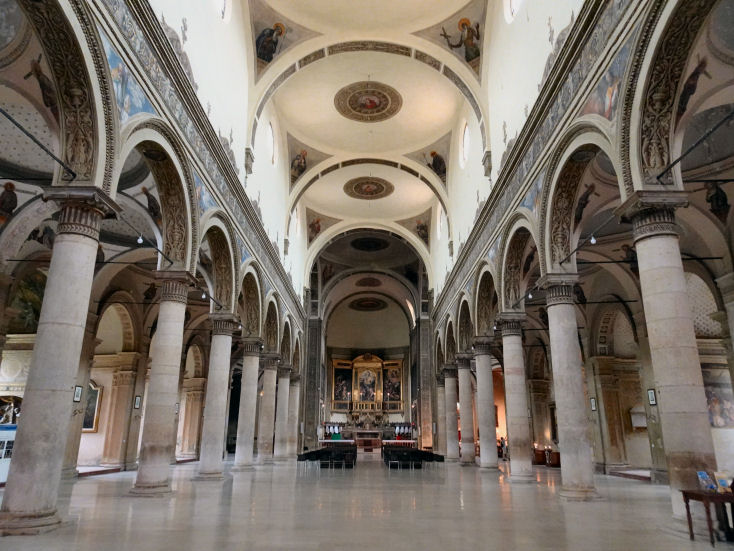

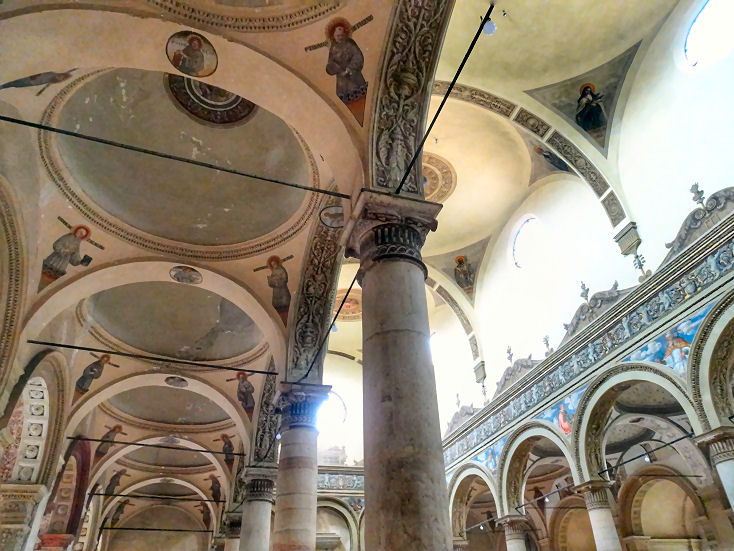
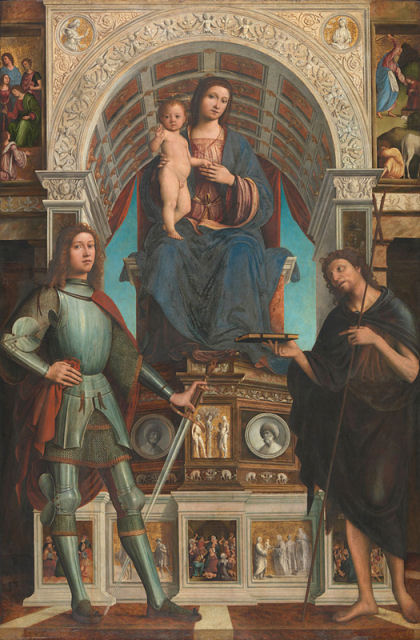
The monastery
The
oratory of the confraternity of the Immaculate Conception of the
Virgin, built between 1498 and 1500 above the refectory here, had as
its high altarpiece a Virgin and Child with Saints George? and
John the Baptist, the so-called Strozzi Altarpiece,
commissioned by Carlo and Camillo Strozzi from
Lorenzo Costa, now in the National Gallery in London. This work has
been ascribed to many artists, but is currently thought to have been
either begun by Costa and completed by Pellegrino Munari, or begun
by Franceso Maineri and revised by Costa. Or not. The altarpiece is
full of subsidiary scenes, often imitating other media - an
Annunciation in roundels in the spandrels of the arch set
against gold mosaic, with old Testament scenes flanking the arch.
There's a Fall of Man panel under the Virgin's feat and a
sequence of alternating painted scenes and reliefs against gold
mosaic at the base, of episodes from the Life of Christ running,
unusually, right to left. A lunette of the Lamentation Over the
Dead Christ with Saints Francis and Bernardino of c.1502, part
of this altarpiece and by Costa and collaborators, is also in the
Pinacoteca.
The oratory was also lined with
late-15th/early-16th-century frescoes by Boccaccio Boccaccino,
with additions by his pupils after his departure, including Michele Coltellini,
Domenico Panetti, Niccol˛ Pisano, and Garofolo.
The oratory had been
used as a warehouse and the frescoes plastered over. Restoration
work in 1957 resulted in their recovery. Of the 13 roundels of
episodes of the Lives of Christ and the Virgin ten were
detached and are now in the Pinacoteca. Below each of them were
panels with profiles portraits of pairs of, it is assumed, members
of the confraternity and seven fragments of these are also in the
Pinacoteca. As is a fresco of Saint Francis Receiving the
Stigmata which was on the wall to the side of the altarpiece,
the one on the other side of The Resurrected Christ Appearing to
a Saint (Anthony of Padua?) is lost. Saints
Anthony
of Padua and Bernardino of Siena are said to have stayed in a
windowless room near the street in the monastery, which had also
been used to imprison rebellious members of Este family. Saint
Bernardino had preached in town against vanity and the long trains
of women's dresses, and fled after being made bishop of Ferrara. The
Confraternity of the Immaculate Conception was suppressed in 1772.
|
|
San Giacomo
Via del Carbone |
History
An 11th-century Romanesque church with claims to even earlier
origins. In the 15th century the floor and roof level was raised. As it
was inside the Jewish ghetto Pope Urban VIII wanted to close it down
in 1627, but local pressure prevailed. Suppressed by Napoleon, it
passed into private hands and has been a cinema for a good while.
Restoration work was carried out in 1935.
Fašade
Largely unchanged from the 11th-century original
Interior
Frescoed inside in 1465 by
Buongiovanni di Geminiano and the presence of mosaics was mentioned
by Cittadella, an 18th-century historian.
Burials
The 18th-century historian Marco Antonio Guarini wrote that this
church was built by the Pagano (or Pagani) family upon arriving in
Ferrara. Among its ancestors was the first grand master of the
Knights Templar, Ugo dei Pagani, and Guarini says that he was buried
here. Also buried here were Ottolino
Mainardi and Aldobrandino degli Este.
Campanile
Collapsed in 1821, damaging the presbytery.
Lost art
A memorial plaque to Ottolino Mainardi is in the Casa
Romei, mentioning Mainardi's involvement in the church building and
dated 1298 (see right) with the family coat of arms under the
inscription.
Opening times
Now a cinema
|
|
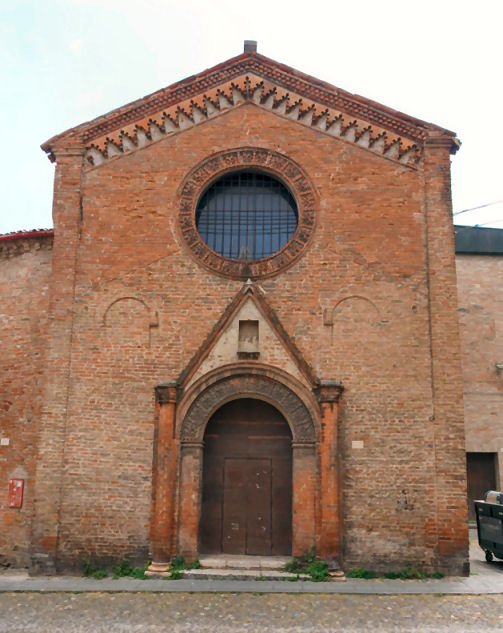
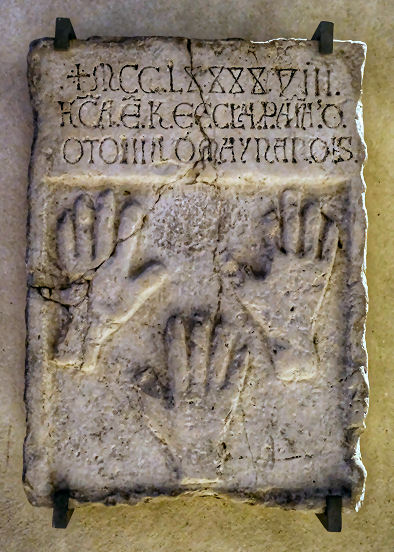 |
|
San Giorgio fuori le mura
San Giorgio Vecchio |
History
This was Ferrara's medieval cathedral from the late 7th century until 1135,
with credible documentary claims that it it was built in 647 and so Ferrara's
oldest church. It is called
San Giorgio "outside the walls" because it's outside the city walls,
built by Borso d'Este in 1451, while the Duomo, also dedicated to Saint
George, is inside the walls. It passed to the Olivetan order in
1415 and was then
rebuilt from 1473 by Biagio Rossetti, with reconsecration in 1476.
Work on the interior in 1581, after the
earthquake of 1570, by Alberto Schiatti unfortunately undid most of Rossetti's
good work. Following cannon damage in 1708/9 there was more work in the 18th century, by Francesco Mazzarelli and Giacomo Bottoni
and a new fašade, to designs by the sculptor Andrea Ferreri.
Fašade
The result of baroque remodelling by Andrea Ferreri in 1722,
who is also responsible for the sculptural work. To the
sides are two statues - Saint George as Bishop of Ferrara on the
left and Saint Lawrence on the right. Over the door there is the
stone relief of Saint George Killing the Dragon. On the crowning
pediment is a cross on three hills with olive branches, the
symbol of the Olivetans.
Interior
visited
A nave and two six-bay aisles, the nave, and elsewhere, covered
in frescoes by Francesco Ferrari from 1690, who is also responsible
for two panels in the presbytery. The decoration is
characteristically Ferrarese, much painted grisaille architectural
detailing, with fake fluting on the columns. Some trompe l'oeil too,
with even some imitation open doors in the presbytery. Each aisle
has two altars and two long benches with large painted panels above
by Costanzo Cattaneo from 1636 and Francesco Naselli. No altarpieces
of interest, or originality - the decoration is the appeal here, I
think.
Of the two chapels flanking the presbytery, at the end of the
left-hand aisle is the chapel of the 7th century Syrian Saint
Maurelius, who was bishop of Voghenza-Ferrara and was martyred just
before this church was built. His remains are in the glass case
under the altar. The Holy Roman Emperor Henry V had a vision of the
saint in 1106 and translated his relics here, which led to strong
local veneration. He was made Ferrara's other patron saint (joining
Saint George) in 1463. The painting of the saint's martyrdom is a
copy by Gennari of the original by Garofalo, now in the Pinacoteca.
In the right aisle is a chapel containing the miracle-working panel
of the Madonna of Salice.
The choir stalls are 15th century and have been
attributed to the Canozio brothers from Lendinara. On the left wall
in the chancel is the 1474 tomb of Lorenzo Roverella, physician to
Julius II and afterwards Bishop of Ferrara, attributed to Ambrogio
da Milano and Antonio Rossellino (see photo below right). The Roverella family
acquired rights to the chancel chapel in 1475 and commissioned a
huge high-altarpiece from Tura (see Lost art below). It is likely
that the altarpiece was moved to a side chapel during remodelling in
the early 1580s. CosmŔ Tura is buried here in a pavement tomb in the
chapel at the entrance to the campanile. The high altarpiece is an
17th century work by Maurelio Scanavini, a pupil of Francesco
Ferrari, depicting Saint George.
The monastery
Had three cloisters, but only one remains (see
photo below). Also a small
theatre from 1739 used for concerts and sacred plays.
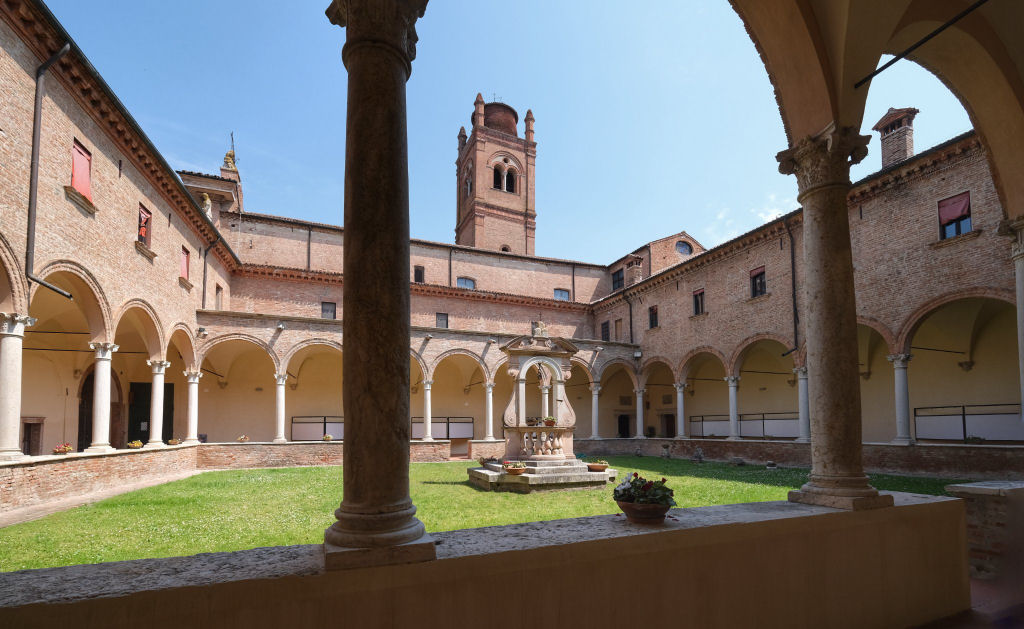
Campanile
The work of Rossetti, completed in 1485 and inspired by the
new Duomo campanile.
Lost art
Two altarpieces by CosmŔ Tura, both
long dismembered and spread wide.
One from the 147os was commissioned to commemorate Lorenzo Roverella, who
had been Bishop of Ferrara from 1460 until his death in 1474, by his
family, who had acquired the rights to the chancel chapel. It was
installed over the high altar in 1487, but moved to a side altar
when the church was rebuilt in the early 1580s. Its
central panel of the Virgin and Child Enthroned is in the National
Gallery in London. The Hebrew inscriptions on the throne, from the
Ten Commandments, are said to reflect Ferrara's prominent Jewish
community, although Christ's head covering the second commandment,
the one about the creation of graven images, has been open to
various interpretations. The lunette which topped this panel, The
Lamentation, is in the Louvre. The right-hand panel was the Virgin
and Child with Saints Paul and Maurelius present a kneeling cleric, now in the Colonna
Collection in Rome. A fragment of the left-hand panel, showing
the head of Saint George, survives, but it originally included Saint
Peter, the saints presenting another kneeling cleric, thought to be Lorenzo Roverella,
knocking to gain admission to the central space. These
side panels were topped with panels, one of the Blessed Bernard Tolomei, founder of the Olivetans, and one of Saint Benedict. Two
tondi, the Circumcision and the Adoration of the Magi
are in Isabella Stewart Gardner and Fogg museums in Boston,
respectively. A tondo of the Flight into Egypt is in the MET. Arguments
still rage as to whether these tondi were parts of the predella from
this altarpiece.
The other is the Saint Maurelius Altarpiece of c.1480, produced for the
saint's chapel in this church, and which housed his relics. Two tondi remain,
now in the Pinacoteca: The Trial of Saint Maurelius and The Martyrdom of Saint Maurelius This altarpiece in 1635 was replaced by one on the same
subject by Guercino. The two tondi were moved to the church's
sacristy and then possibly to the attached monastery. They 'came
into the possession' of Filippo Zafferini who in 1817 gave them to
Ferrara.
An Adoration of the Magi of 1537 by Garofalo is in the
Pinacoteca. It's a late work but Vasari describes it as 'one of the
best works he ever did in all his life'. Also by Garofalo in the
Pinacoteca is his Martyrdom of Saint Maurelius, a copy of
which, by Gennari, is in the saint's chapel here.
Fifteen fresco tondi of saints' busts by Girolamo da Carpi and Garofalo
from c.1537, now in the Pinacoteca, displayed high up in the sala
multimediale.
A dark Martyrdom of Saint Maurelius of 1634-5, by Guercino
on canvas, in the Pinacoteca since 1836, which replaced the Tura
altarpiece in the saint's chapel here.
Opening times
10.00 - 12.00 & 4.00 - 6.00
|
|
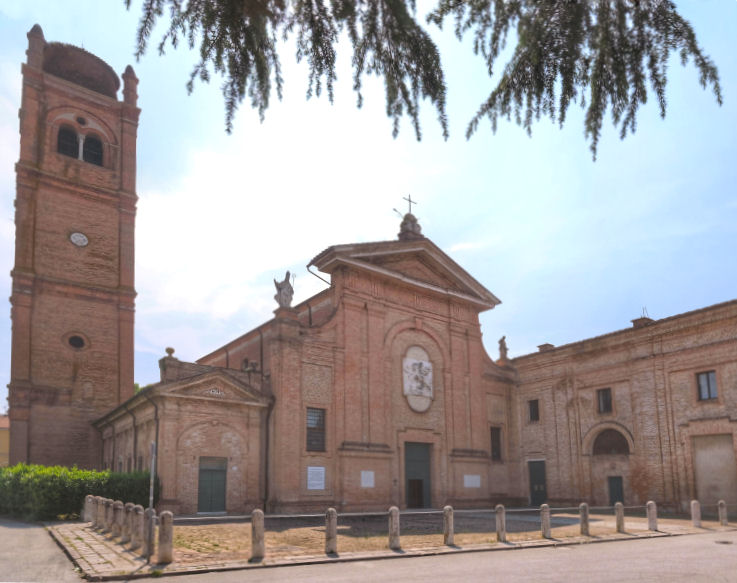
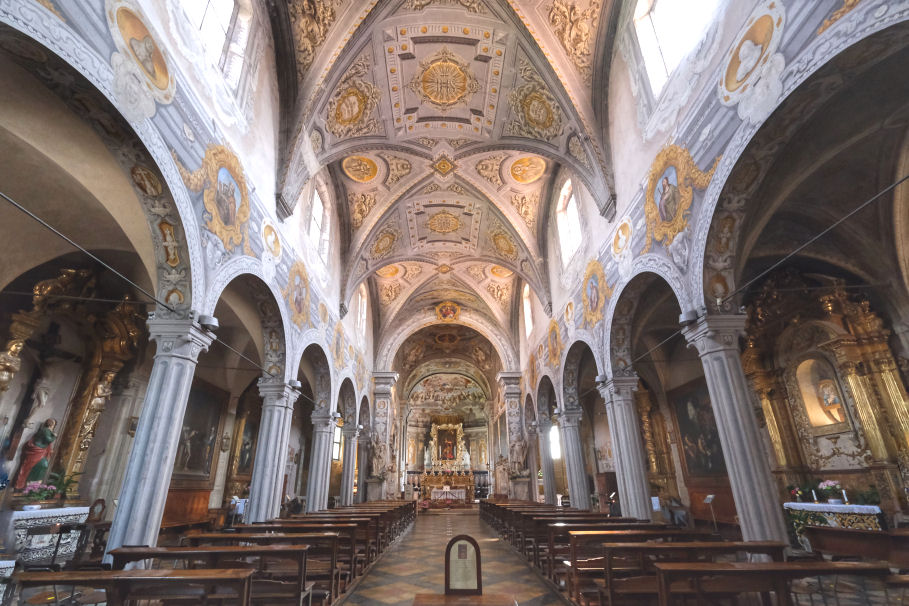
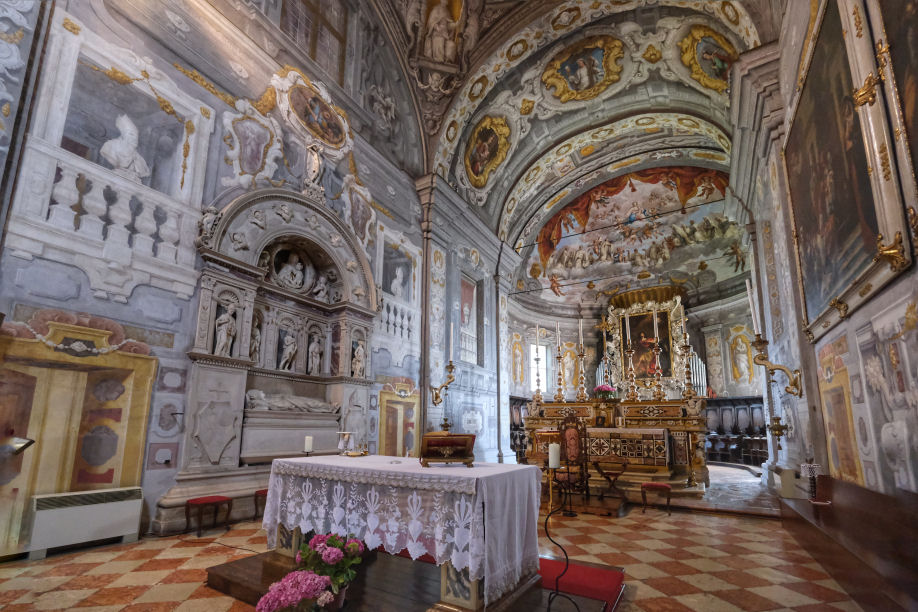
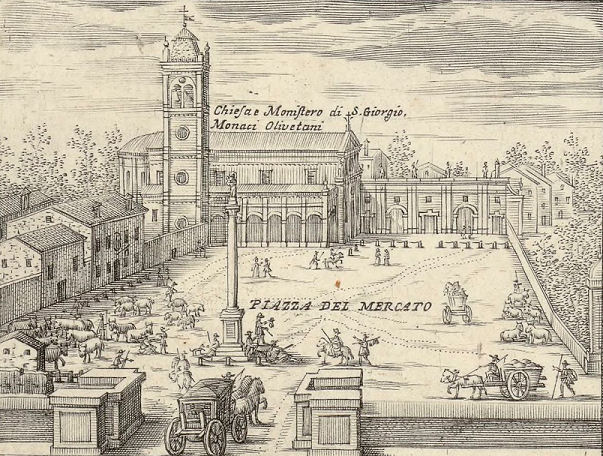
An illustration from the
18th century map of Ferrara by Andrea Bolzoni.
|
|
San Giovanni Battista
Via Montebello & Corso Porta Mare |
History
The Augustinian Order of Lateran Canons had settled nearby in
the
12th century and then been moved from their unhealthy first site,
the plague hospital (and oratory) of San Lazzaro, by Ercole 1 d'Este
in 1474. In 1496 he gave them the land on which they built this
church and monastery from 1505-8. The architect was Francesco Marighella but
recent scholarship suggests that construction began in the apse to plans by
Biagio Rossetti, although some sources say the Duke Ercole himself designed it. An earthquake in 1570 caused damage resulting in rebuilding by architect Alberto Schiatti, probably resulting in a smaller church.
The monks here were expelled from in 1796 transferring to
Santa
Maria in Vado. To be replaced by the Benedictines, then the
Somascans, who were expelled in 1810. The catechumens took over in
1821 and then from 1826 to
1834 the church was run by the Knights of Malta who made the complex into a
hospital, before they moved to Rome in 1855.
The church reopened for worship in 1938 but was closed
again after suffering bomb damage and finally closed in 1954. Acquired by
the municipality of Ferrara in the 1990s, the church underwent restoration. After
the 2012 earthquake it temporarily reopened pending the restoration of the other
churches in the parish of Santo Spirito.
Interior
Said to be the only church in Ferrara with a Greek cross plan and
dome. Frescoes are said to remain.
The Deposition of c.1605 and The Beheading of St John the
Baptist of c.1603, both by Scarsellino. The latter is unusual
for showing the saint's just-severed head in mid-air and may now be
in the Musei Civici di Arte Antica.
Local history
On 2nd February 1502 Lucrezia
Borgia made her spectacular ceremonial entry into Ferrara as the new
bride of Alfonso d'Este. The sounds of church bells, trumpets and
cannon accompanied her and just outside San Giovanni a cannon
startled Lucrezia's horse and she was thrown off, but she picked
herself up and continued on
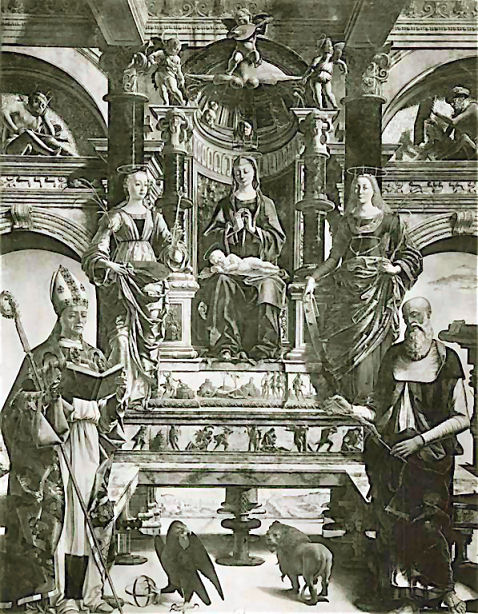
Lost art
An altarpiece of the Virgin and Child enthroned
with Saints Apollonia, Augustine and Jerome by Ercole de' Roberti
(see right) had been brought here by the Augustinians from their church of San Lazzaro. It was
Roberti's first important independent commission and the first
unified field sacra conversazione to be painted for a
Ferrarese church. It was in the
Kaiser Friedrich Museum in Berlin and was destroyed in 1945 in the
fires in the Friedrichshain flak tower (Flakturm)
where paintings from the Berlin collections were being stored to
protect them from bombing.
Opening times
Currently closed
|
|
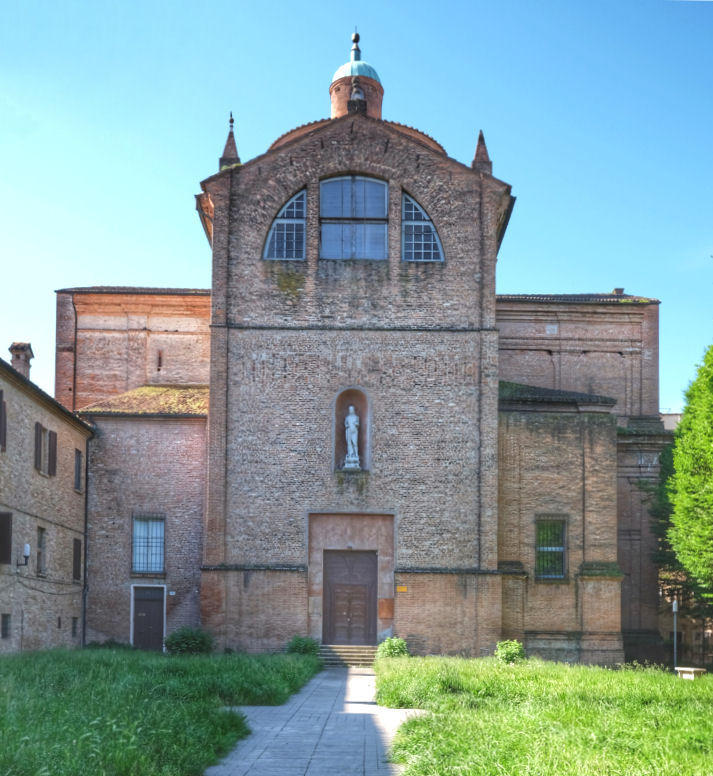
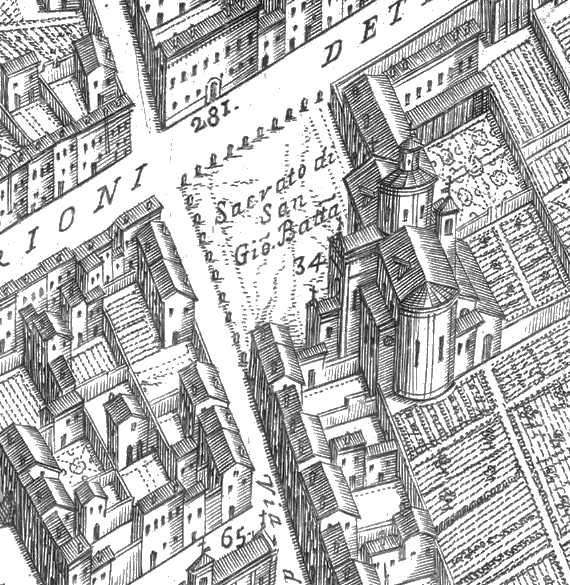
A detail from the 18th century map
of Ferrara by Andrea Bolzoni
|
|
San Girolamo
Via Savonarola |
|
History
Land in the medieval part of Ferrara was given to the
Jesuits by Nicol˛ dall'Oro (called Ziponari) who had built an oratory here by1378, and in 1428 Giovanni Tavelli da Tossignano, who later became bishop of
Ferrara, had a church built next to it, which was then destroyed after the
suppression of the Jesuits in 1671.
The church was rebuilt from 1703 to 1712 to plans by Giulio Panizza for the
Barefoot Carmelite fathers. They remained until the
Napoleonic suppressions, but returned in 1821.
Fašade
The marble portal is from
the suppressed church of Sant'Anna. The two 18th-century statues in the lower
niches, attributed to Andrea Ferreri, are of Saint Teresa of ┴vila and Saint John of
the Cross
Interior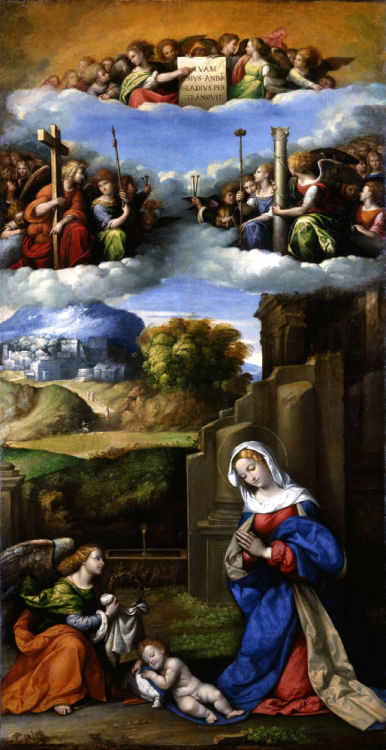
Centrally-planned with a deep apse. Art mostly from the 18th century
and painted for the Carmelites.
The altarpiece of the second
chapel on the right, The Apparition of St. Joseph to Saint Teresa of ┴vila,
and the frontal of the first on the left, Saint Simon Stock and the
Virgin and Child, are both by the Paduan Pietro Benati (or Bonatti).
On the second altar on the left is a Crucifixion in polychrome stucco by Pietro Turchi from the mid-18th
century.
The high altarpiece of Saint
Jerome in the Desert is by Francesco Pellegrini, also from the mid-18th century.
Saint George and Saint Maurelius by Bastarolo painted for the old church in the
late 16th century, are
now in the first chapel on the left.
Tombs
Alessandro Aldobrandini (1734)
and the Blessed Giovanni Tavelli da Tossignano, bishop of Ferrara between 1431
and 1446, who built the adjacent Gesuati convent with an adjoining
oratory.
Local heretic
The church
faces the house (no. 19) where Savonarola
spent the first 20 years of his life.
Lost art
A panel depicting Saint
Jerome (and a somewhat heraldic lion) by Vicino da Ferrara
from c.1475-80, said to be the artist's mature masterpiece. in the Pinacoteca.
The unusual Virgin Adoring the Christ Child with the Instruments of the
Passion of 1517 (see right) by Garofalo is now in Dresden. It was the
high altarpiece here.
Opening times
Currently closed
Update May 2022 The overgrown grassy area in front
of the fenced-off fašade is still full of fallen stone urns, taken down after
the 2012 earthquake for safety and visible still in situ in the old photo
right.
|
|
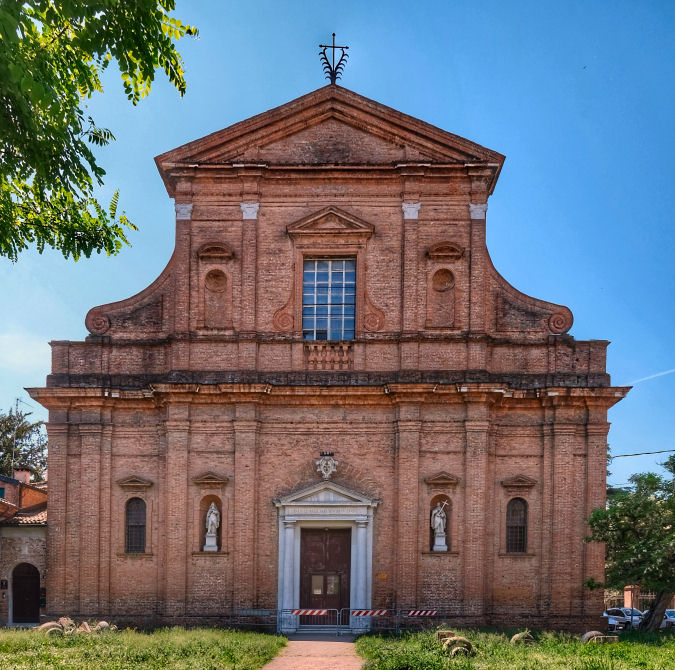
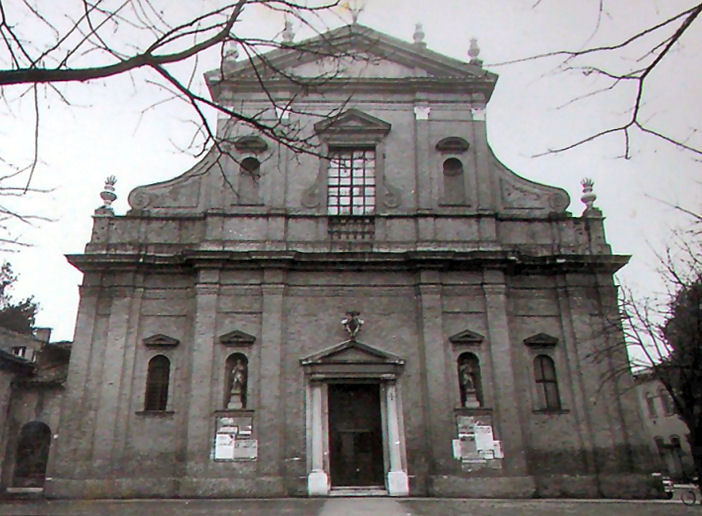
|
|
San Giuliano
Piazzetta delle Castello |
|
History
The original small church here was demolished
by Marquis Nicol˛ I in 1385
to make way for
the moat of the Castello. By 1405 it had been
rebuilt in Gothic style thanks to a donation from Galeotto degli
Avogari, and connected to the Order
of the Santo Sepolcro. Baroqued up inside in the 18th century, like
the Duomo, and suppressed by Napoleon.
Later bought by the priest Don Pietro dalla Fabbra, who saved it from
demolition, then inherited by Don Santino Fiori and later by Cardinal
Luigi Giordani.
Restoration in in 1895 and in 1957 was paid for by Cristiano Nicovich,
for use by the press association,
employing engineer Carlo Savonuzzi, after which it became known as the
church of journalists. In June 2006 the church was returned to the Ferrara
Curia thanks to the Fondazione Cassa di Risparmio di Ferrara who bought
the building at a liquidation auction.
Altars inside were dedicated to the Albergatori (inn-keepers),
Orefici (goldsmiths), and to the Arte dei Beccai (fishmongers, butchers, and restaurateurs).
Fašade
The doorway has spires topped by
Annunciation figures of Gabriel and the Virgin flanking
Christ in the centre. Above is an
oculus window with an odd relief below it showing an episode in the
life of the church's name saint, Julian the Hospitaller (San Giuliano
lĺOspitaliere) when he murdered his parents in their sleep.
Interior
An 18th century guidebook to the churches of Ferrara by Scalabrini
mentions an altarpiece of Saint Julian by Giacomo Bambini and Cesare Croma; a
Bishop Saint Eligius
attributed to either Scarsella or Pordenone; a Martyrdom of Saint Andrew
by Bartolommeo Solati, painted for the fishmongers; and a Saint Luke by Menagatti.
Wikimedia Commons has a photograph of an
18th century
ceiling fresco of The Virgin in Glory with Saints Julian, Eligius, Andrew
and Luke, by Giovan Battista Ettori and Massimo Baseggio, showing the
ceiling to be in a very poor state.
Opening times
Currently closed
Update May 2024 Covered in sheets and
scaffolding, because it is finally getting its post-earthquake rebuilding
work, a poster tells us.
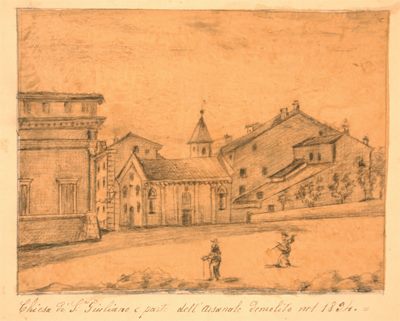
|
|
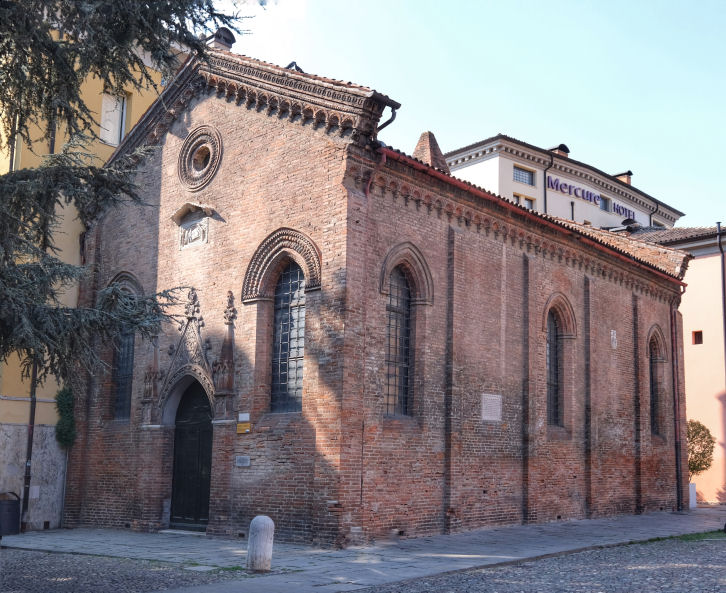
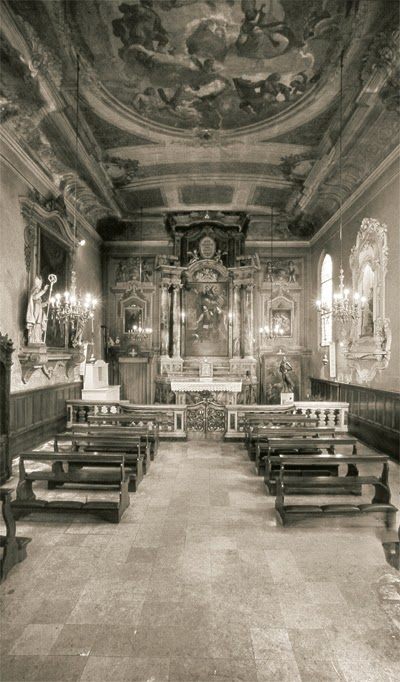
|
|
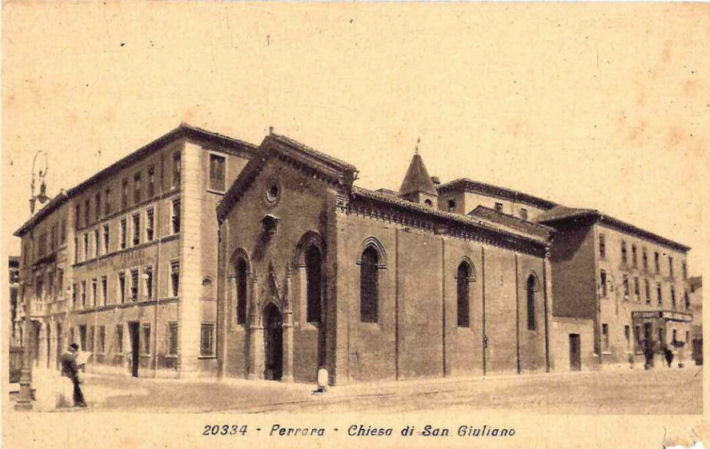
|
|
San Gregorio Magno
via Cammello |
History
The first documentary proof, a
mention by Pope Leo VIII, confirms that this was a parish church by 964,
making it one of the Ferrara's oldest. Over the nest two centuries two
rectors of the parish, Giocanni Battista Bertazzoli and Melchiorre Sacrati,
presided over considerable work on the interior and fašade. Further
work in the 18th century instigated by Don Antonio Ughi, who had found the
church crumbling and the rectory unsafe, involved the lengthening of
the church, with a new choir and a larger transept. There was a rededication by
Cardinal Alessandro Mattei on April 13th 1788.
In 1932 the facade was restored to return it
to its Gothic appearance which the 18th century work had spoiled - the
pointed-arched marble and terracotta doorway and windows and the rose
window were put back.
Interior
The walls were whitewashed in the 1950s.
The chapel on the right is dedicated to Saint Gregory the Great, with a
canvas by Alberto Mucchiati showing him with Saint Clement.
The left-hand chapel is dedicated to Saint John of Nepomuk, in a canvas
attributed to Giuseppe Ghedini. In here is the baptismal font with a
marble basin of the 16th century on a base taken from the pier of the port
of Classe, used as a dock in the time of Augustus.
The transept arch is flanked by two 17th century statues in niches of St.
John the Baptist (on the right), and of St. John the Evangelist (on the
left), by Antonio Magnani. They used to be in the church of San Romano.
Above the high altar since 1958 has been a stone niche housing a wooden
statue of the Madonna of Lourdes, a work from 1884 by the Bolognese
Federico Monti moved from another part of the church. Although this church
is dedicated to Pope Gregory the Great his feast (September 3rd) has not
been celebrated here since being replaced by the celebrations of the
Madonna of Lourdes from around 1864, barely six years after the apparition
of the Immaculate Conception to Bernadette. This church is known in
Ferrara for this devotion, celebrated on 11th February.
Campanile
Dates to 1092 and so said to be the oldest
in the city and built for a local noblewoman. It's Romanesque up to the
bell cell which has pointed arches like the doorcase and which dates back
to at least the 13th century.
|
|
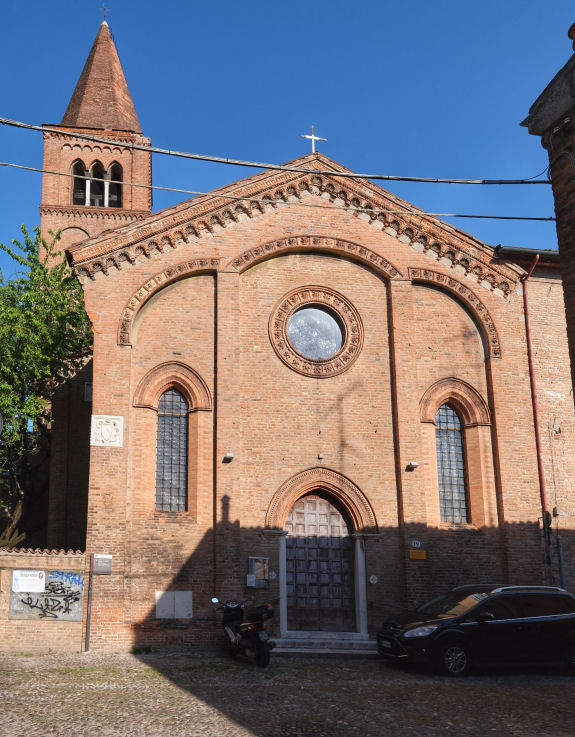 |
San Martino
Via Fondobanchetto |
|
San Matteo del Soccorso
via Montebello |
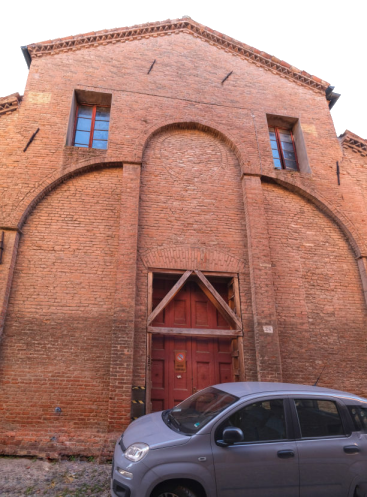
History
A parish church first mentioned in 972. From the
14th century, it passed to the Benedictine abbey of San Bartolomeo which was
outside the walls, and in the 16th century they undertook rebuilding, moving the
entrance to the east and adding aisles with three lateral arches. They stayed
until suppression in 1656, when the church passed to San Pietro. A few years
later the confraternity of the Santissimo Sacramento acquired the church from
the rector of San Pietro along with the adjoining former Benedictine monastery.
Closed by Napoleon in 1796, the church reopened in 1810.
Today it is privately owned and serves as a car park.
Lost art
The Virgin and Christ Adored by Saint Martin
and Francis by Giacomo Parolini in the Pinacoteca.
Opening times
Currently closed
|
|
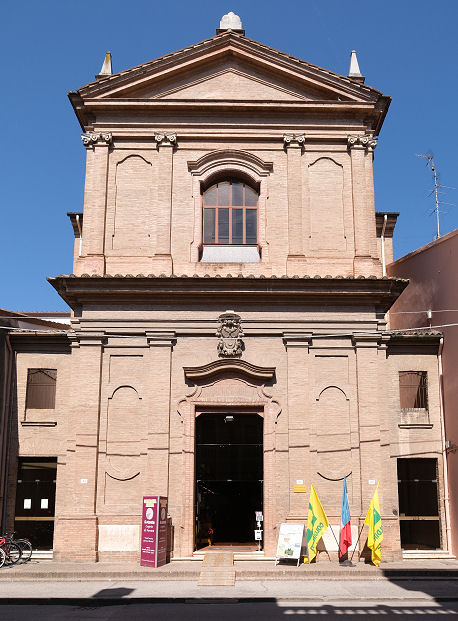
History
A small oratory was built here in 1580 by duchess Lucrezia d'Este, with a
hospice for separated and battered wives which later also took in repentant
prostitutes. The church was rebuilt in 1755 by Cardinal Marcello Crescenzi with
three altars, designed by Francesco and Angelo Santini. From 1758 to 1870 it was
a parish church and officiated until 1910. It was then closed and, seriously
damaged by bombing in 1944, was then sold and converted into warehouse. Since
May 2019 it has been a covered produce market, all bare inside.
Apostles and Evangelists by Carlo Bonfatti, from the old oratory, were reported
in in the church's presbytery in the 18th century by Scalabrini.
Opening times
Now a produce market with a very
stripped-out and characterless interior.
|
San Maurelio
Corso Porta Po |
|
San Michele Arcangelo
via del Turco /piazzetta San Michele |
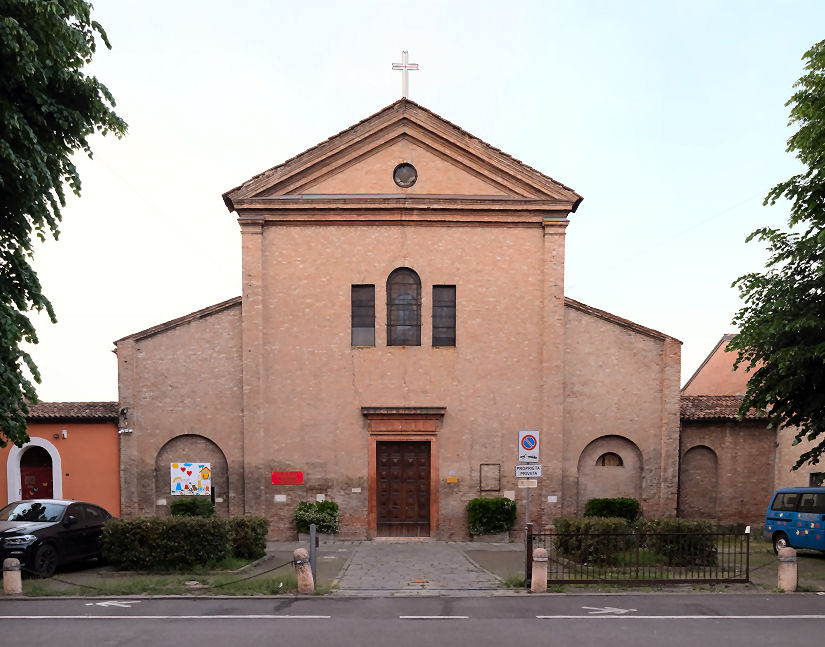
History
In 1106 Henry V, Holy Roman Emperor had a vision of Saint Maurelius
and translated the 7th-century Syrian saint's relics to the church of San
Giorgio in Ferrara. This resulted in great local veneration of the saint and in
1463 he became Ferrara's patron saint, often portrayed in Ferrarese art, such as
CosmŔ Tura's 1470 Saint Maurelius Altarpiece for San Giorgio fuori le mura,
where the saint's relics remain.
This church was built, with its monastery, in 1612-15, commissioned by the Marquis Enzo Bentivoglio
for Capuchin friars who had had to leave their monastery to make way for the Papal
Fortress. It was damaged by bombing in the Second World War.
Interior
Until the bombing of 1944 the high altarpiece was The Visitation by
Camillo Ricci (or Rizzi), who was a pupil of Ippolito Scarsella.. There was also The Centurion and the Redeemer and the Virgin
and Child with and Saint Felix of Cantalice by Carlo Bononi. Felix of
Cantalice was the first Capuchin friar to be named a saint, by Pope Clement XI
in 1712.
Opening times
Currently closed |
|
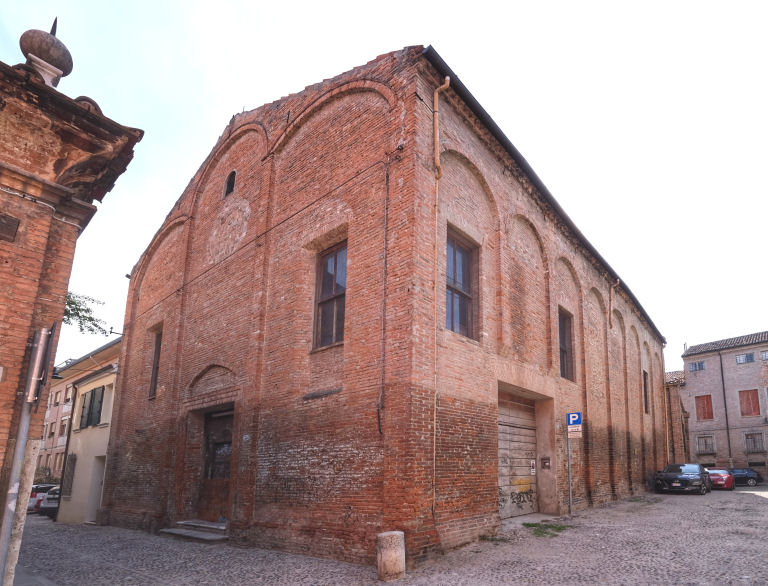
History
This is one of Ferrara's oldest churches, being
mentioned in a document dated 962. At first connected to the abbey
of San Bartolo, it later passed to the Cistercians of Santa Maria in
Aula Regia in Comacchio. Rebuilt in 1479, this is the church we see
today. From 1561 to 1767 the Canani family patronage resulted in the
ceiling of the church being painted, depicting Saint Michael and the
Evangelists. In the mid-17th century, a Saint Michael was painted
in the niche over the entrance. Closed and stripped of all art
during by Napoleon, it however remained open and in 1806 it became a
parish church. In 1843 the facade was restored and plastered. The
church was deconsecrated in 1932 with worship moved to the church of
the Ges¨ despite local protests. From 1980 it housed a
restoration laboratory and from 2012 was used as an ADO charity
shop. Permission for use as a car park was denied by the
Sovrintendenza.
Interior
The apse was added in the 16th century, the rectangular windows even
later. The ceiling paintings from the 1560s by Gregorio Gregori of The Victory of
Saint Michael over the Rebel Angels and the Evangelists remain
in place, we are told.
Update May 2024 The building was put up for sale in 2019 and in 2021 was
bought by clothes designer Francesca Liberatore with the intention of using it
as exhibition space for her father, Bruno, who is a sculptor. As the doors are
now polished dark hardwood and there are cameras and keypads I assume that
something of this nature has occurred.
|
San Nicol˛
Via Colomba 4-6/Piazzetta San Nicol˛ |
|
History
The original church and
Benedictine priory here was built in the 12th century, tradition claims 1103,
and in 1183 it became a parish church. Rebuilt after the collapse of the
campanile at the expense of the Pasqualetti family. After the rebuild
completed in 1475 Duke Ercole I d'Este gave the priory to Augustinian friars
from San Girolamo da Fiesole. The friars began to rebuild, employing the duke's architect Biagio Rossetti, but the work was
limited to enlarging the apse as the friars lacked funds. The work was completed in
1499.
In 1610 the Augustinians employed Camillo Ricci (a pupil of Scarsellino) to decorate the ceiling of the
nave with 84 square panels telling the life of Saint Nicholas of Mira.
The
friars remained until 1668, when their order was suppressed by Pope Clement IX. In
1688 the church and convent passed to the Somascans. They were suppressed and stripped in
1796 by Napoleonic troops and in 1801 by the Cisalpine Republic.
In 1809 the complex became a prison for 'insurgents or brigands' and in 1811 it was acquired by the
municipality of Ferrara. In 1820, wild animals were housed here, and in 1825 the church
and convent were used as barracks and stables by the Austrians, which use lasted until the 1930s.
In 1936 a plan to reopen the space in front of the church was approved, so as to
bring the church back to its original external appearance.
From 1984 to 1986 archaeological work in the Piazzetta San Nicol˛ confirmed
written history, finding the foundations of the campanile, which collapsed in
1380, and traces of the old church, which had served as a basis for the
reconstruction of the apse at the end of the 15th century. Also several burials
were found in an external cemetery located to the right of the church, under
what was later the sacristy, which had been later still demolished.
Deconsecrated
and gutted and currently housing a club, a dance gym and an art school.
Campanile
The bell tower collapsed on 29 June 1380 and was also rebuilt in 1475, then demolished in the 19th century.
Lost art
A Noli me Tangere by
Scarsellino of c.1600/10 from the Riminaldi chapel here, now in the Pinacoteca
The Saint Anthony of Padua from 1484/90 by CosmŔ Tura from an
altarpiece made for Francesco Nasello, the ducal secretary (or
possibly for Ercole I's nephew Nicol˛ Gurone.) It is now in
the Estense Gallery in Modena, but was still here in the 18th century.
The 84 square panels telling the life of Saint Nicholas of Mira by Camillo Ricci
(a pupil of Scarsellino) were the artist's major work. He painted them in 1610 to decorate the ceiling of the
nave. They were sold and lost after the Napoleonic suppression.
A plaque commemorating the expansion of this church commissioned by
Duke Ercole I in 1476.
An altarpiece by Niccol˛ Pisano The Holy Family and Saints from
1520 (see right) commissioned by Giovanni Andrea deĺ
Gilardoni for his family chapel. It is now in the Worcester
Museum, in Worcester, Massachusetts
Opening times
Deconsecrated
and used by a club, a dance gym and an art school. |
|


|
|
San Paolo
Piazzetta Schiatti |
History
There was a parish church here in the
10th century. In 1295 it passed to the Carmelites. Over the next two
centuries a monastery was built with two cloisters, with
Renaissance-style rebuilding after the 15th century. Following the
earthquake of 1570, rebuilding of the church was entrusted to
Alberto Schiatti. (The church now faces onto the Piazzetta
Schiatti). Construction began in 1575, making it one of the last Este
churches, the monastery was enlarged and the church was
reconsecrated in 1611. Following the Napoleonic suppressions the monastery was
converted into a prison and the church remained open as a parish
church.
The church was closed for worship in 2006, six
years before the earthquake that is blamed for all of Ferrara's
church closures It reopened on the 27th of April 2024.
Interior
Retains much of its original decoration. 16th/17th-century
paintings and frescoes.
Along the aisles are 18th-century
terracotta sculptures by the otherwise unknown Filippo Bezzi and Francesco
Casella.
Left aisle
Descent of Holy Spirit by Scarsellino.
Resurrection and Circumcision of Jesus by Bastianino.
Right aisle
Birth of St John the Baptist by Scarsellino.
An Annunciation by Bastianino.
Right Transept
Saint Jerome (under the organ) by Girolamo da Carpi.
Presbytery
The Adoration of the Magi, The Conversion of Saint Paul and
The Martyrdom of Saint Paul
by Domenico Mona.
Apse
Elijah Transported to Heaven in a Chariot, a vault fresco by Scarsellino,
from the 1590s.
Frescoes on one wall of the choir from before the 14th century.
Campanile
10th century and all that's left of the first church.
It was built by the Leuci family and is one of the few surviving defensive
family towers left in Ferrara.
Lost art in the Pinacoteca
Sixteen impressive late 14th-century wooden panels of
full length Saints by a Maestro Veneto, possibly Stefano di Sant'Agnese.
A 15th century panel of Saint Anthony Abbot by an anonymous master from
the Veneto-Emilia region.
Nicol˛ Pisano's The Martyrdom of Saint Sebastian, with Saints Joseph,
Job and Members of the Mori family of c.1508/9
A Saint Jerome in the Desert panel by
Girolamo da Carpi from c.1532-4.
Lost art elsewhere
Fragments of a 15th-century terracotta window frame from the convent here is in
the Casa Romei.
Opening times
Saturdays 3.00 - 6.30
May 2024 update Various local news items and
YouTube videos reveal that the restoration work is complete and that the church
reopened on the 27th of April. But only at the time given above.
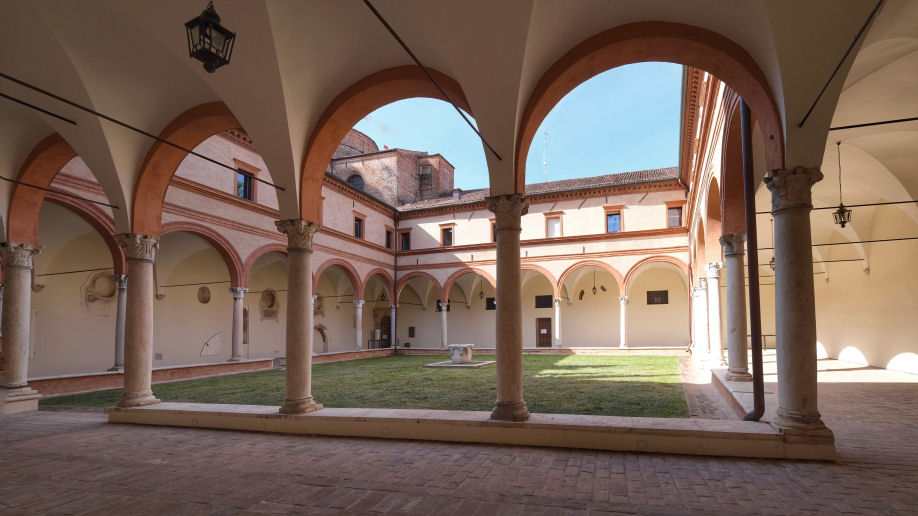
The convent and cloisters
The first cloister (Chiostro dei
Politici) adjacent to the west side of the church had been built by
1330. The second cloister ('...of the Cisterna' or '...of the
Clock') is mentioned in 1423. In the late 14th/early 15th century
a refectory and library were built, off of the cistern cloister.
The
refectory has a coffered ceiling and a band of frescoes below it, on
three sides, dated 1506, restored in 1992, depicting saints, blesseds and other images. More fresco work from the same century came to light during the same restoration work in the room
above. Following the Napoleonic suppressions the complex was converted into a
jail, which it remained until 1912, when the prisoners were
transferred to new prison in via Piangipane.
The complex was then put to various uses. During the Second World War the
wing on via Boccaleone was severely damaged by bombing. In the 1940s
and 50s homeless families occupied part of the former prison. Some
work was carried out after the war, but the first real restoration
came in 1963-64, by the Municipality of Ferrara who had owned the
complex since 1906. At this time the first cloister and the
surrounding wings were spruced up for the police. More work later in
the 1960s, in the 1980s, at the beginning of the 1990s and more
recently. Currently the two cloisters house municipal offices, the
Institute of Renaissance Studies and the Sala della Musica.
|
|
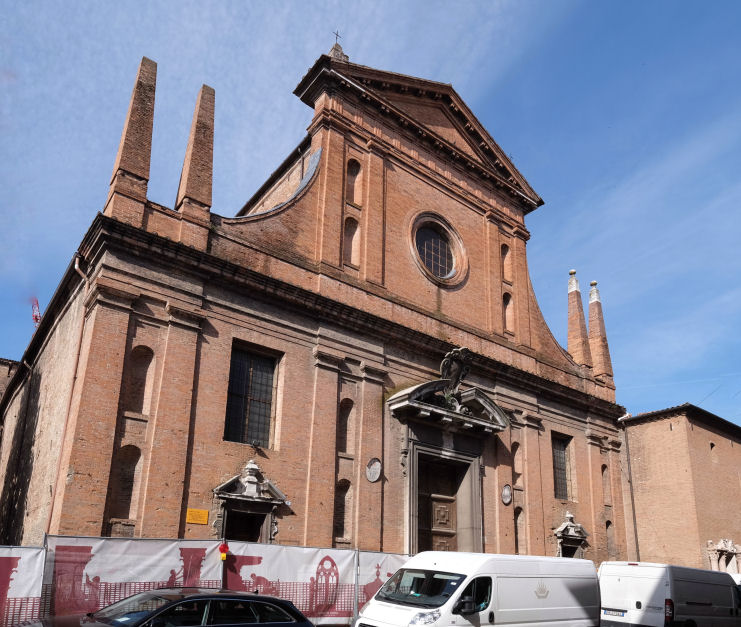

Post-restoration interior photos by
Jeanette McCauley

|
San Pietro
Via Porta San Pietro/Via Spilimbecco |
|
History
There is said to have been a church built here
around 952 and that it was a subsidiary base for the bishop of Ferrara, whose
cathedral was then San Giorgio fuori le mura. A monastery was built here in 1010, the
gift of Bishop Ingone for the canons of the cathedral.
Rebuilding followed in 1530, which included the reorientation of the fašade from west to
east. More work at the end of the 15th century, in the 16th and again in 1745.
Following suppression by Napoleon the complex was sold and changed hands many
times, being used as a warehouse, a gym, a ballroom and, as its reputation
became more notorious, a theatre and a porno cinema, which it remained, until it
recently closed, called
the Cinema Mignon Per Adulti.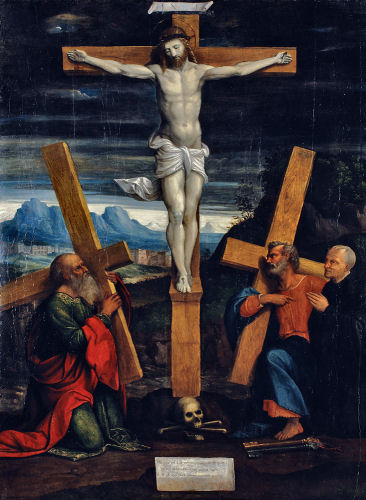
The most important recent restoration plans were in 1941, when plans
to restore the facade
faithfully were prevented by a lack of any good documentation
recording how it looked.
Lost art
Two frescoes by Garofalo from the first half of the
16th century, representing Saints Peter and Paul, later detached
and moved to the atrium of the Duomo. Also by Garofalo is the odd Crucifixion
with Saints Andrew and Peter and the donor Bernardino Barbuleio in the
Pinacoteca now (see right), painted c.1544 for the altar of the Crucifix here. Barbuleio was a
poet and grammarian and close friend of Garofalo.
Opening times
Currently closed |
|
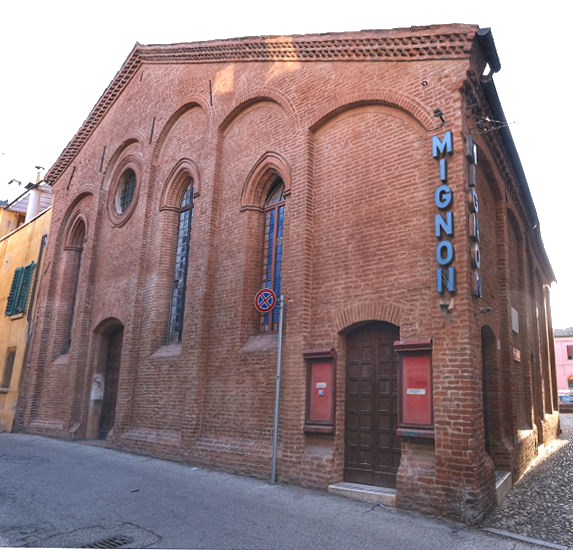
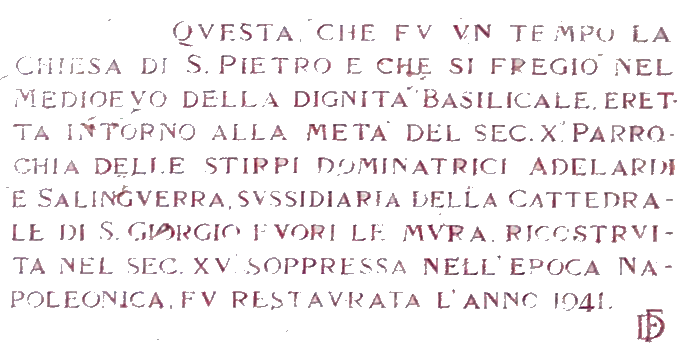
|
Sant'Agnese
Via del Carbone |
|
Sant'Agnesina
Via del Carbone |
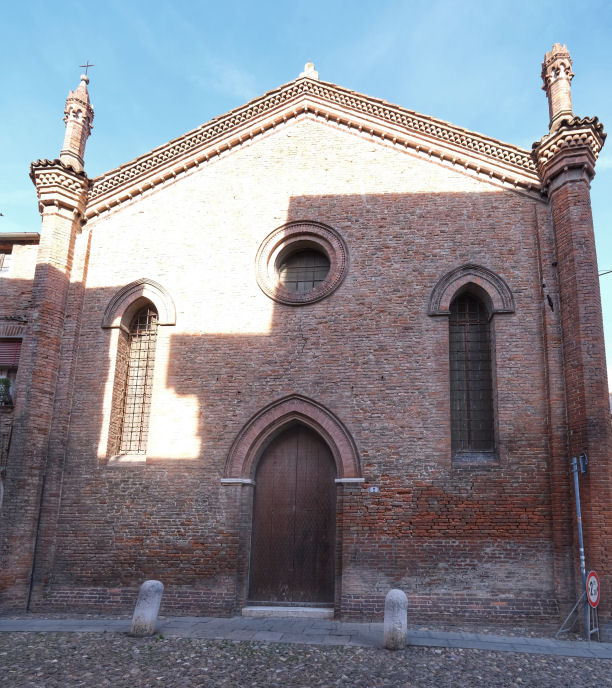
History
A parish
church since at least 1114. Documented in 1159 as a Benedictine
monastery. Enlarged from the early 15th century including work on
the the facade and the campanile.
On the floor inside was once an
eight-pointed star, the symbol of Pomposa and its monastery,
indicating burials here of Benedictine monks, but no trace remains.
In the 18th century, the prior here was historian Ludovico Antonio
Muratori, who carried out major renovations. Later that century
changes to the interior were carried out by architect Francesco
Azzolini.
Suppressed in 1806 but reopened
shortly after by the Pia Congregazione Artieri e Mercanti. Major
restoration again in 1841, with fresh frescoes. Structural work in
1927 by the congregazione, followed by some final restoration in
1936.
Opening times
Currently closed
|
|
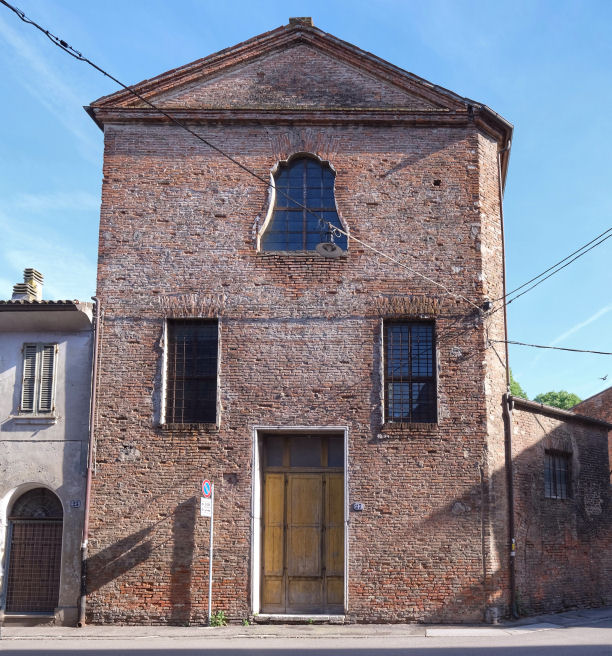
History
This church, dedicated to Saint Agnes, is known as Sant'Agnesina
(little Saint Agnes) to distinguish it from the monastery church of
Sant'Agnese over the road.
Was an oratory and a
hospital, documented in 1365, with the hospital probably having
existed since the 12th century. The hospital was closed in 1498 and all the hospital functions were concentrated at Sant'Anna.
In 1544 Ercole II d'Este decided to dedicate it to orphans.
An upper floor housed the orphans and the sick and the lower housed
the oratory. There was renovation work in 1766 - 67 by a pupil of the architect
Francesco Mazzarelli, but the complex was suppression by Napoleon in 1796 (with the
orphans transferred to the convent of Santa Caterina da Siena)
resulted in
use as a warehouse. Reopened in 1824 by Cardinal Odescalchi as a
University church and run by the Compagnia del Ges¨, with the
dedication to San Luigi Gonzaga. Suppressed again in 1859 and then
used as a carpentry shop by the physics department of the University
of Ferrara, it is currently disused, pending planned post-earthquake
restoration for educational use.
Opening times
Currently closed
|
|
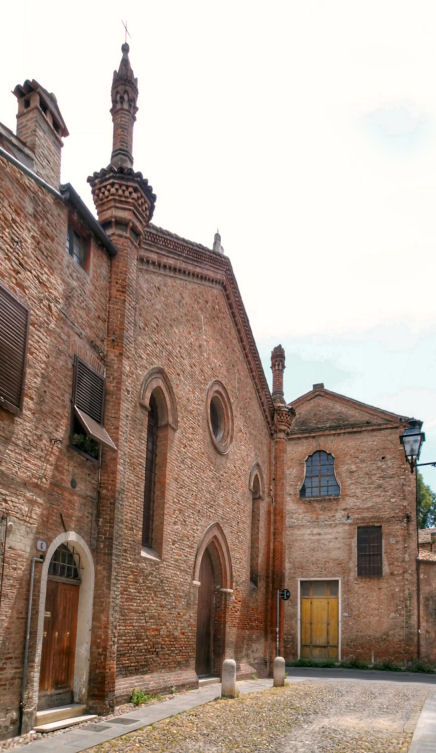
Sant'Agnese is on the left,
Sant'Agnesina to the right. |
|
Sant'Antonio Abate
via Saraceno and via
Cavedone |
|
|
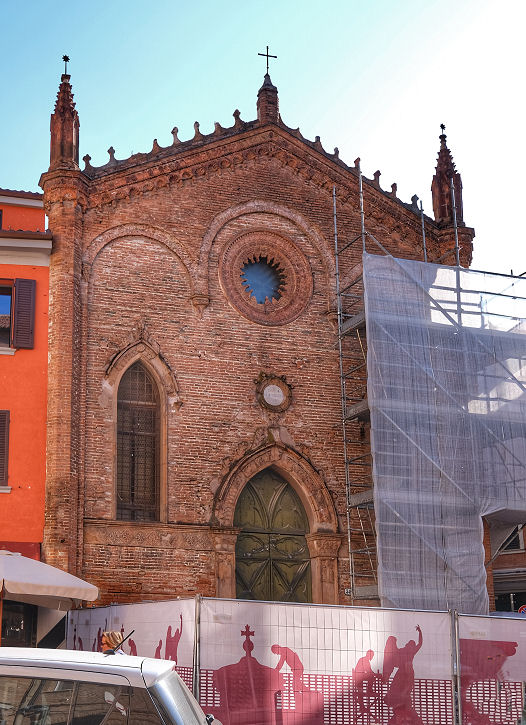
History
Built in the 14th century
by friars from Vienne, a French town to which relics of the saint
had been brought from the East in the 11th century. By 1410 it was a
priory. Rebuilt in 1584, suppressed in 1796 by Napoleon, but
rededicated, with major work in 1864 and 1866 - the fašade was
rebuilt by Antonio Tosi Foschini in Gothic style. Only the
15th-century choir survived this rebuilding mostly unchanged.
Along the fašade of via Cavedone there is a
17th-century shrine depicting the Crucifixion, the work of
Francesco Robbio, restored in 2000.
Lost art
An Agony in the Garden
by Dosso Dossi in the Pinacoteca has Sto Antonio
inscribed on its reverse, leading to suggestions that it came from
this church.
Three panels from 1539 forming an altar frontal, by the Master of
the Twelve apostles, who was trained by Garofalo. The
Resurrection and The Pentecost are in the Pinacoteca,
The Ascension is in Berlin.
Opening times
Currently closed
Update May 2024 The scaffolding now
covers the whole church.
|
|
Sant'Antonio in Polesine
Via Beatrice II dĺEste |
|
History
Founded before 1000, the
original monastery here was established by the Eremitani di SantĺAgostino
on what was then an island in the River Po, before it changed
course. This alteration involved reclaimed land and the inclusion of this
land within the addition to Ferrara made by Borso d'Este.
Polesine means a tract of land crossed by waterways. The church
that remains was consecrated in 1412.
An Augustinian convent dedicated to Sant'Antonio
Abate was founded here in 1249 for Borso's daughter Beatrice who had
decided to become a nun after her fiancÚ died. Beatrice adopted the
Benedictine rule in 1252, died
in 1264 and was beatified in 1270, when the convent here was rebuilt
using material from the the nuns' previous church of Santo Stefano
della Rotta di Focomorto. The cloister flanking the church here has
her relics and marble tombstone (see photo below) from which healing 'manna' is said
to issue. More work followed in the 15th and 16th centuries.
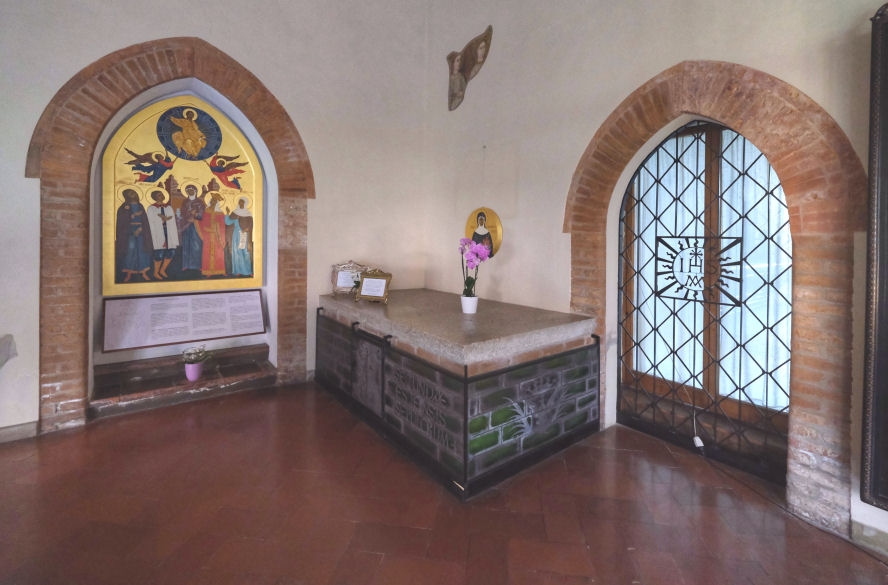
Located just outside the city the church was used to lodge
important guests on their way to visit Ferrara. These
included Bianca Maria Visconti, coming to meet her future husband
Francesco Sforza on 26th September 1440 and Pope Pius II on 16th May
1459 on his way to the Council in Mantua.
Interior visited
The fascinating frescoes are shown by one of the 15 nuns
who still live here (and are well-known locally for their singing,
to the accompaniment of a lyre).
The church is divided into two
parts, the public and Baroque western part with a trompe ceiling by
Francesco Ferrari, and the older east end with the nunsĺ choir
with its intarsia-work stalls of the
late 15th century.
The east end of the east end has three chapels with frescoes from the
14thľ16th centuries, characterised by odd, and Byzantine, iconography.
The north chapel
of the three has frescoes from the early 14th century, very influenced by
Giotto representng the early life of Christ and of the Virgin. The Visitation
unusually includes Zacharias and the Flight into Egypt is unique in
showing Christ on Josephĺs shoulder, instead of in the
Virginĺs lap. On the left wall, The Dormition of the Virgin is Byzantine
in showing Jesus in a mandorla holding the
personification of the Virginĺs soul in the form of a baby.
In the
south chapel the cycle continues, with the scenes of The Agony in
the Garden, Judasĺs
Betrayal and The Mocking of Christ on the left wall, all by the same school of painters
who painted the north chapel. Christ ascending the ladder to the Cross,
in the lunette on the right wall, is very unusual. From later
in the 14th-century and by different
painters (with more of a Bologna influence evident) are the scenes
of The Dance of Salome (with Salome a biblically-authentic child
see below right), Christ in Limbo, The Crucifixion,
The Deposition and The Entombment, also Saint John the Baptist and
Saint
John the Evangelist flanking the window.
The frescoes in
the central chapel are mainly 15th century, whereas the
vault is decorated with grotesques of the late 16th century by
Bastianino. There are
lunettes on the side walls depicting the scallop shell of Santiago de Compostela
as pilgrims travelling there, along
the Via Romea, departed from this church. On the walls are
representations of the Virgin Enthroned among Saints, and of
martyrs and Doctors of the Church. The Virgin and Child
Between Saints Benedict and Sebastian (1433) is by Antonio
Alberti, an artist from Ferrara who Vasari said was a pupil of Agnolo
Gaddi, which is chronologically impossible. There is The Stoning
of Saint Stephen on the right wall, and The Coronation of the
Virgin. Also an Annunciation by Domenico Panetti. The wooden Crucifix
above is
attributed to the school of CosmŔ Tura.
Beyond the central chapel is a
room decorated with 17th-century painted ceiling panels and
a 16th-century panel of The Virgin and the Mysteries of the
Rosary
over the altar, with a fresco of The Flagellation attributed to Ercole deĺ Roberti
on the entrance wall. There is a set of polychromed terracotta
Lamentation figures in a small room with iron gates.
Lost art
The Lamentation by
Garofalo from in 1527 is in the Brera in Milan.
In the Pinacoteca:
Two eight-pointed-star-shaped panels of the
Virgin and Child and God
the Father, used as ceiling panels in the small
dormitory here, painted by the Maestro dagli Occhi Spalancati
(Master of the Wide-Open Eyes) c.1480-90. A third such panel Saint Scholastica,
remains in situ. By the same artist, who also worked on the
Palazzo Schifanoia frescoes, the Pinacoteca also has a fine
three-panel altar frontal from this church, showing The
Visitation, The Birth of Saint John the Baptist and
The Martyrdom of Saints Peter and Paul. It looks to have been
commissioned by someone from the Este family. Another
altar frontal looking like an Este commission, of The Nativity and The Adoration of
the Magi by the Maestro dell'Adorazione di Ferrara from 1450.
Three
altar frontal panels by Bastianino from
c.1560-70 showing
The Birth of the Virgin,
The Adoration
of the
Shepherds, and
The Assumption.
Opening times Ring for
nun-guided admission,
9.30ľ11.30 & 3.15ľ4.45; closed Sun
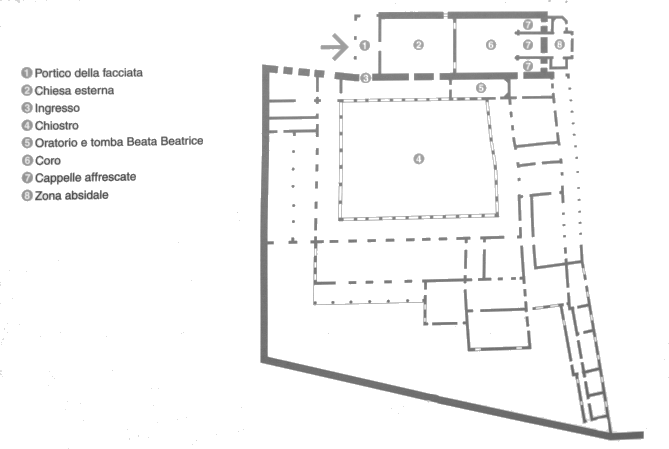 |
|
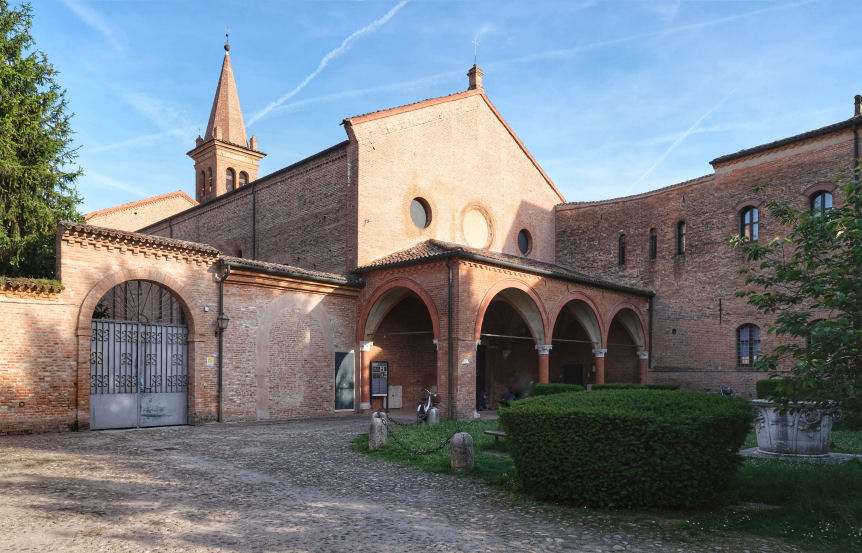
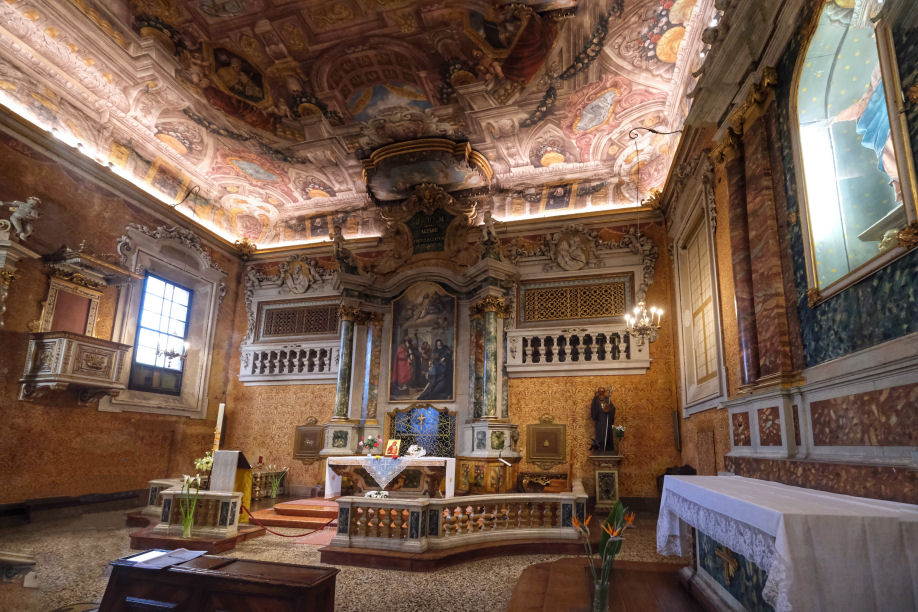
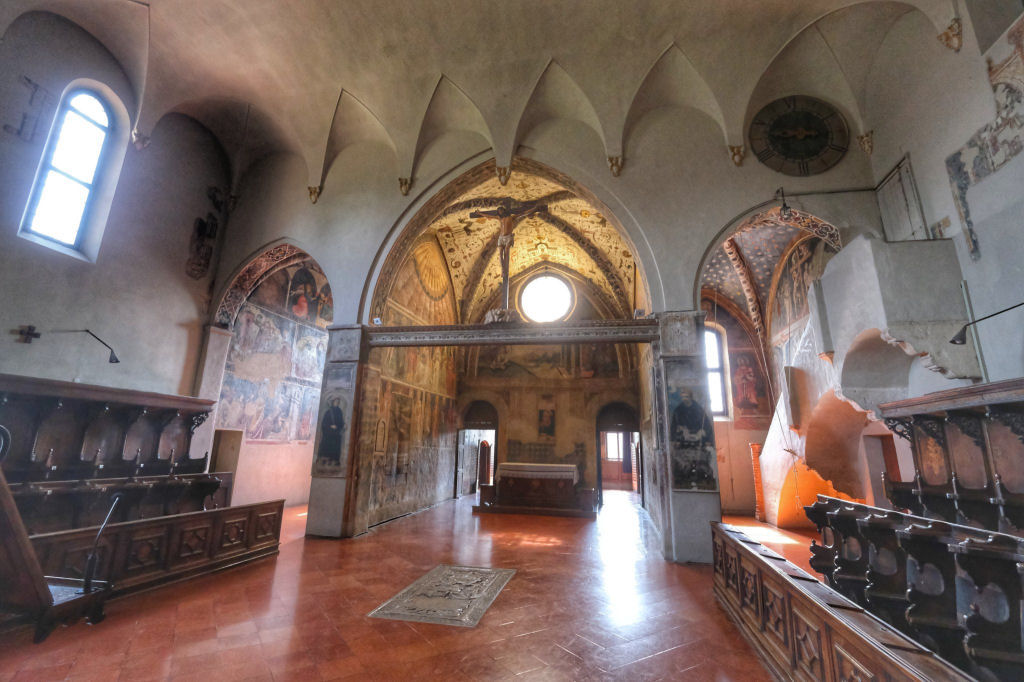
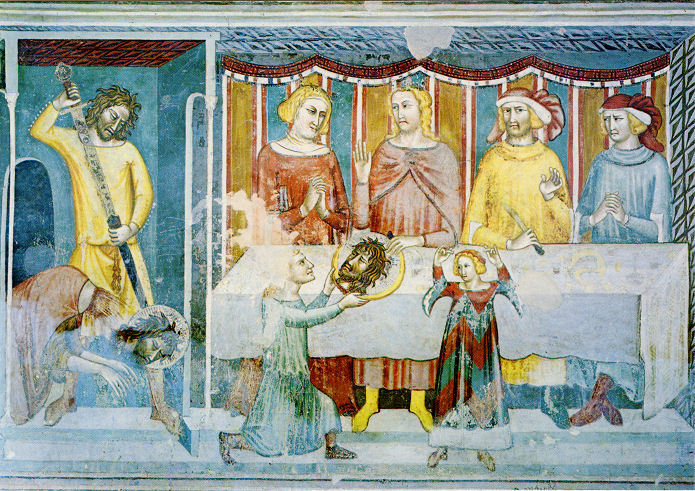
|
|
|
SantĺApollonia
via XX Settembre |
|
|
|
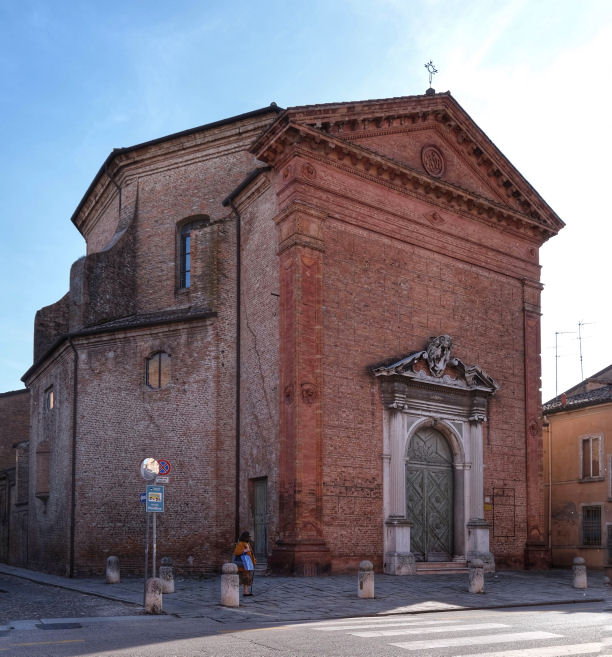
History
The original small oratory her was built for the Confraternita della Morte (or Battuti Neri ) in the 15th century. It
was rebuilt larger in 1612 to an octagonal plan, and enlarged
again in 1662, acquiring it's current form, to designs by Francesco
Mazzarelli, during which time it was entrusted to third order
Franciscans and then consecrated on 16th March 1693. There's an 18th-century
organ by Domenico Fedeli. The church was
closed in 1975 and deconsecrated a few years later. It fell into a
serious state of neglect and decay until restoration and
redevelopment for use as a new exhibition space for the nearby
national archaeological museum of Ferrara.
The portal came from the demolished church of Spirito Santo in 1839.
The Madonna del Bastione came here when
Santa Maria del Buon
Amore up the road, towards the walls, was demolished
in 1924.
Opening times
Currently closed |
 main altar.
main altar.
















